#edison fairbanks
Explore tagged Tumblr posts
Text

Time breaks down your mind and body Don't you let it touch your soul It was like an age-old classic The first time that you saw me The story started when you said, "Hello" In a crowded room a few short years ago And sometimes there's no proof, you just know You're always gonna be mine We're gonna be I'm gonna love you when our hair is turnin' gray We'll have a cardboard box of photos of the life we've made And you'll say, "Oh my, we really were timeless"
3 notes
·
View notes
Text
Masterpost of every character who has already competed
We do take requests for future brackets! Before you request a character be included in a future bracket, check this list first to make sure they haven't already competed.
Lena Adams Foster (The Fosters) Elida Al-Feyr (Vagrant Queen) Nyssa Al Ghul (Arrow) Cassie Ainsworth (Skins) Luisa Alver (Jane the Virgin) Winter Anderson (American Horror Story: Cult) Miss Audrey (Snowpiercer) Babs (A Series of Unfortunate Events) Saanvi Bahl (Manifest) Bambi (Minx) Josephine Barry (Anne with an E) Sister Beatrice (Warrior Nun) Bilquis (American Gods) Maya Bishop (Station 19) Sarah Bishop (A Discovery of Witches) Alana Bloom (Hannibal) Cheryl Blossom (Riverdale) Anne Bonny (Black Sails) Kelly Booth (Black Mirror) Nova Bordelon (Queen Sugar) Nancy Botwin (Weeds) Dana Bryant (Mythic Quest) Robin Buckley (Stranger Things) Lena Burnham (Ray Donovan) Calliope Burns (First Kill) Delia Busby (Call the Midwife) Amanita Caplan (Sense8) Wendy Carr (Mindhunter) Chanel #3 (Scream Queens) Max Chapman (A League of their Own) Piper Chapman (Orange is the New Black) Denise Christopher (Timeless) Grace Choi (Black Lightning) Cassandra Cillian (The Librarians) Jade Claymore (Willow) Dani Clayton (The Haunting of Bly Manor) Raelle Collar (Motherland: Fort Salem) Dulcie Collins (Deadloch) Delphine Cormier (Orphan Black) Theo Crain (The Haunting of Hill House) Frannie Crowne (Brave New World) Moiraine Damodred (The Wheel of Time)
Alex Danvers (Supergirl) Ashley Davies (South of Nowhere) Carina DeLuca (Station 19) Jo Deluca (A League of Their own) Bo Dennis (Lost Girl) Clare Devlin (Derry Girls) Rosa Diaz (Brooklyn Nine-Nine) Franky Doyle (Wentworth) Camina Drummer (The Expanse) Waverly Earp (Wynona Earp) Kat Edison (The Bold Type) Philippa Eilhart (The Witcher) Mabel Elmsworth (The Buccaneers) Camile Engelson (Stitchers) Eretria (The Shannara Chronicals) Isobel Evans (Roswell New Mexico) Dana Fairbanks (The L Word) Juliette Fairmont (First Kill) Emily Fields (Pretty Little Liars) Veronica Fisher (Shameless) Fleabag (Fleabag) Flower (Ghosts) Gabrielle (Xena: Warrior Princess) Lupe Garcia (A League of Their Own) Bibi Garvey (Bad Sisters) Mirror Philippa Georgiou (Star Trek: Discovery) Gigi Ghorbani (The L Word: Gen Q) Stella Gibson (The Fall) Sue Gilbert (Dickinson) Emily Grace (Murdoch Mysteries) Yara Greyjoy (Game of Thrones) Monet de Haan (Gossip Girl) Judy Hale (Dead to Me) Yuri Han (XO, Kitty) Millie Harcourt (The Bletchley Circle) Nicole Haught (Wynonna Earp) Lauren Heller (Younger) Emma Hernandez (Vida) Pamela Isley (Batwoman) Susan Ivanova (Babylon 5) Bradley Jackson (The Morning Show) Alice Jones (Once Upon a Time) Tara Jones (Heartstopper) Quinn Joseph (Harlem) Kate (One Mississippi) Annalise Keating (How to Get Away with Murder) Tina Kennard (The L Word) Kennedy (Buffy the Vampire Slayer) Yasmin Khan (Doctor Who)
Aneela Kin Rit (Killjoys) Camille L'Espanaye (The Fall of the House of Usher) Victorine LaFourcade (The Fall of the House of Usher) Lagertha (Vikings) Shelly Lambert (Minx) Sara Lance (Arrowverse) Lauren Lewis (Lost Girl) Lexa (The 100) Maggie Lin (Saving Hope) Anne Lister (Gentleman Jack) Veronica Lodge (Riverdale) Santana Lopez (Glee) Lucretia (Spartacus) Lyria (The Shannara Chronicals) Tara Maclay (Buffy the Vampire Slayer) Elizabeth Macmillan (Miss Fisher’s Murder Mysteries) Queen Maeve (The Boys) Maggie (Good Omens) Sofia Marchetti (Sex Education) Margot (Once Upon a Time) Bess Marvin (Nancy Drew) Cara Mason (Legend of the Seeker) Max (Black Sails) Katherine Mayfair (Desperate Housewives) Ally Mayfair-Richards (American Horror Story) Mazikeen (Lucifer) Shane McCutcheon (The L Word) Betty McRae (Bomb Girls) Lake Meriwether (Love, Victor) Freya Mikaelson (The Originals) Sandy Milkovich (Shameless) Mabel Mora (Only Murders in the Building) Ellen Morgan (Ellen) Rory Morningstar (Lucifer) Aleesha Morrison (Upload) Hayes Morrison (Conviction) Blanche Mottershead (Upstairs Downstairs)
Mulan (Once Upon a Time) Leighton Murray (Sex Lives of College Girls) Raffi Musiker (Star Trek: Picard) Susie Myerson (The Marvelous Mrs. Maisel) Nadja (What We Do in the Shadows) Nicky Nichols (Orange is the New Black) Nico (Vida) Nina (Good Omens) Allie Novak (Wentworth) Dani Núñez (The L Word: Gen Q) Ola Nyman (Sex Education) Shona O'Keefe (This Way Up) Kelly Olsen (Supergirl) Van Palmer (Yellowjackets) Marjorie Palmiotti (Veep) Gail Peck (Rookie Blue) Aline Penhallow (Shadowhunters) Valencia Perez (Crazy Ex-Girlfriend) Laura Peterson (The Morning Show) Lindsay Peterson (Queer as Folk) Anissa Pierce (Black Lightning) Brittany S. Pierce (Glee) Naomi Pierce (Succession) Alice Pieszecki (The L Word) Eve Polastri (Killing Eve) Bette Porter (The L Word) Bill Potts (Doctor Who) Arthie Premkumar (GLOW) Amae Rali (Vagrant Queen)
Scylla Ramshorn (Motherland: Fort Salem) Amy Raudenfeld (Faking It) Logan Rawlings (Young & Hungry) Maia Rindell (The Good Fight) Arizona Robins (Grey's Anatomy) Eve Rothlo (How to Get Away with Murder) Root (Person of Interest) Willow Rosenberg (Buffy the Vampire Slayer) Kenya Rosewater (Defiance) Susan Ross (Seinfeld) Siuan Sanche (WoT) Ellaria Sand (Game of Thrones) Jenny Schecter (The L Word) Jinju Seong (Snowpiercer) Seven of Nine (Star Trek: Voyager & Star Trek: Picard) Toni Shalifoe (The Wilds) Kalinda Sharma (The Good Wife) Carson Shaw (A League of Their Own) Sameen Shaw (Person of Interest) Leslie Shay (Chicago Fire) Amy Silva (Vigil) Bea Smith (Wentworth) Petra Solano (Jane the Virgin) Rose Solano (Jane the Virgin) River Song (Doctor Who) Kitty Song Covey (XO, Kitty) Serena Southerlyn (Law & Order) Zelda Spellman (Chilling Adventures of Sabrina) Maya St. Germain (Pretty Little Liars) Moira Strand (The Handmaid’s Tale) Della Street (Perry Mason) Tamsin (Lost Girl) Kit Tanthalos (Willow) Stahma Tarr (Defiance) Jamie Taylor (The Haunting of Bly Manor) Thirteen (House, MD) Thirteenth Doctor (Doctor Who) Tara Thornton (True Blood) Bess Till (Snowpiercer)
Tituba (Salem) Toni Topaz (Riverdale) Callie Torres (Grey’s Anatomy) Fabiola Torres (Never Have I Ever) Taissa Turner (Yellowjackets) Two / Portia Lin (Dark Matter) Alex Vause (OITNB) Mel Vera (Charmed) Villanelle (Killing Eve) Karen Walker (Will & Grace) Martha Walker (Silo) Poussey Washington (Orange is the New Black) Ellen Waverly (For All Mankind) Kerry Weaver (ER) HG Wells (Warehouse 13) Sterling Wesley (Teenage Bounty Hunters) Nora West-Allen (The Flash) Jayne Wetherby (Dracula) Lucy Westenra (Dracula) Ilana Wexler (Broad City) Ryan Wilder (Batwoman) Carol Willick (Friends) Lana Winters (American Horror Story) Bernie Wolfe (Holby City) Camile Wray (Stargate Universe) Xena (Xena: Warrior Princess) Meh Yewll (Defiance) Yorkie (Black Mirror - San Junipero)
15 notes
·
View notes
Text
THE 236 GREATEST PERSONALITIES IN THE ENTIRE KNOWN HISTORY/COLLECTIVE CONSCIOUSNESS OF THIS WORLD! (@INDIES)
i.e. THE 236 GREATEST PERSONALITIES IN WORLD HISTORY! (@INDIES)
Rajesh Khanna
Lionel Messi
Leonardo Da Vinci
Muhammad Ali
Joan of Arc
William Shakespeare
Vincent Van Gogh
Online Indie
J. K. Rowling
David Lean
Nadia Comaneci
Diego Maradona
Wolfgang Amadeus Mozart
Meena Kumari
Julius Caesar
Harrison Ford
Ludwig Van Beethoven
William W. Cargill
Fritz Hoffmann-La Roche
Samuel Curtis Johnson
Sam Walton
John D. Rockefeller
Andrew Carnegie
Roy Thomson
Tim Berners-Lee
Marie Curie
James J. Hill
Cornelius Vanderbilt
Roman Polanski
Samuel Slater
J. P. Morgan
Cary Grant
Dmitri Mendeleev
John Harvard
Alain Delon
Ramakrishna Paramhansa (Official God)
The Lumiere Brothers, Auguste & Louis
Carl Friedrich Benz
Michelangelo
Maharishi Mahesh Yogi
Ramana Maharishi
Mark Twain
Swami Sri Yukteswar Giri
Bruce Lee
Bhagwan Krishna (Official God)
Charlemagne
Rene Descartes
John F. Kennedy
Bhagwan Ganesha (Official God)
Walt Disney
Albert Einstein
Nikola Tesla
Alfred Hitchcock
Pythagoras
William Randolph Hearst
Cosimo de’ Medici
Johann Sebastian Bach
Alec Guinness
Nostradamus
Christopher Plummer
Archimedes
Jackie Chan
Guru Dutt
Amma Karunamayi/ Mata Parvati (Official God)
Peter Sellers
Gerard Depardieu
Joseph Safra
Robert Morris
Sean Connery
Petr Kellner
Aristotle Onassis
Usain Bolt
Jack Welch
Alfredo di Stefano
Elizabeth Taylor
Michael Jordan
Paul Muni
Steven Spielberg
Louis Pasteur
Ingrid Bergman
Norma Shearer
Dr. B. R. Ambedkar
Ayn Rand
Jesus Christ (Official God)
Luciano Pavarotti
Alain Resnais
Frank Sinatra
Allah (Official God)
Richard Nixon
Charlie Chaplin
Thomas Alva Edison
Alexander Graham Bell
Wright Brothers
Arjun (of Bhagwan Krishna’s Gita)
Jim Simons
George Lucas
Swami Sri Lahiri Mahasaya
Carl Lewis
Brett Favre
Helen Keller
Bernard Mannes Baruch
Buddha (Official God)
Hugh Grant
K. L. Saigal
Roger Federer
Rash Behari Bose
Tiger Woods
William Blake
Jesse Owens
Claude Miller
Bernardo Bertolucci
Subhash Chandra Bose
Satyajit Ray
Hippocrates
Chiang Kai-Shek
John Logie Baird
Geeta Dutt
Raphael (painter)
Bhagwan Shiva (Official God)
Radha (Ancient Krishna devotee)
George Orwell
Jorge Paulo Lemann
Catherine Deneuve
Pierre-Auguste Renoir
Bill Gates
Bhagwan Ram (Official God)
Michael Phelps
Michael Faraday
Audrey Hepburn
Dalai Lama
Grace Kelly
Mikhail Gorbachev
Vladimir Putin
Galileo Galilei
Gary Cooper
Roger Moore
John Huston
Blaise Pascal
Humphrey Bogart
Rudyard Kipling
Samuel Morse
Wayne Gretzky
Yogi Berra
Barry Levinson
Patrice Chereau (director)
Jerry Lewis
Louis Daguerre
James Watt
Henri Rousseau
Nikita Krushchev
Jack Dorsey
Dev Anand
Elia Kazan
Alexander Fleming
David Selznick
Frank Marshall
Viswanathan Anand
Major Dhyan Chand
Swami Vivekananda
Felix Rohatyn
Sam Spiegel
Anand Bakshi
Victor Hugo
Bhagwan Sri Sathya Sai Baba (Official God)
Steve Jobs
Srinivasa Ramanujam
Lord Hanuman
Stanley Kubrick
Giotto
Voltaire
Diego Velazquez
Ernest Hemingway
Francis Ford Coppola
Michael Douglas
Kirk Douglas
Mario Lemieux
Kishore Kumar
James Stewart
Douglas Fairbanks
Confucius
Babe Ruth
Raj Kapoor
Titian aka Tiziano Vecelli
El Greco
Francisco de Goya
Jim Carrey
Mohammad Rafi
Steffi Graf
Pele
Gustave Courbet
Rani Laxmibai of Jhansi
Milos Forman
Steve Wozniak
Georgia O’ Keeffe
Mala Sinha
Aryabhatta
Magic Johnson
Patanjali
Leo Tolstoy
Tansen
Henry Fonda
Albrecht Durer
Benazir Bhutto
Cal Ripken Jr
Samuel Goldwyn
Mumtaz (actress)
Panini
Nicolaus Copernicus
Pablo Picasso
George Clooney
Olivia de Havilland
Prem Chand
Imran Khan
Pete Sampras
Ratan Tata
Meerabai (16th c. Krishna devotee)
Queen Elizabeth II
Pope John Paul II
James Cameron
Jack Ma
Warren Buffett
Romy Schneider
C. V. Raman
Aung San Suu Kyi
Benjamin Netanyahu
Frank Capra
Michael Schumacher
Steve Forbes
Paramhansa Yogananda
Tom Hanks
Kamal Amrohi
Hans Holbein
Shammi Kapoor
Gerardus Mercator
Edith Piaf
Bhagwan Shirdi Sai Baba (Official God)
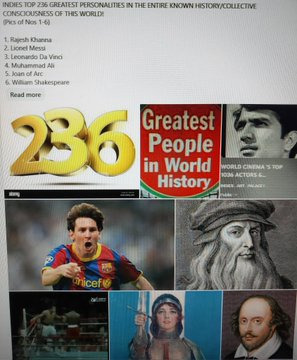


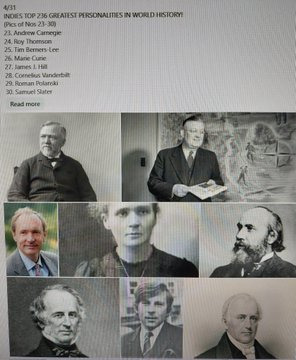
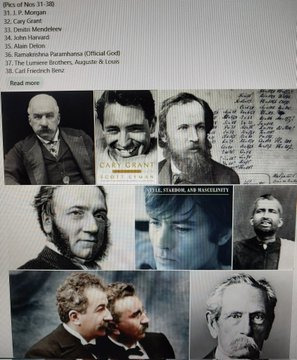
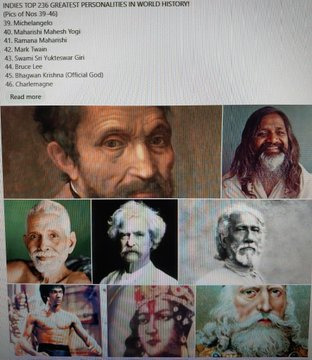
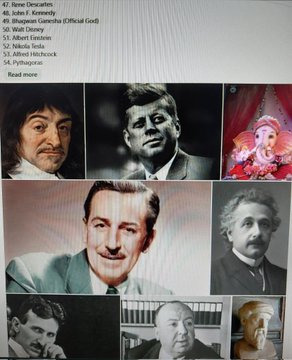

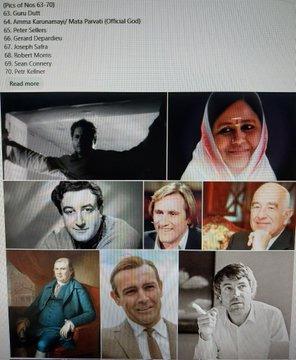



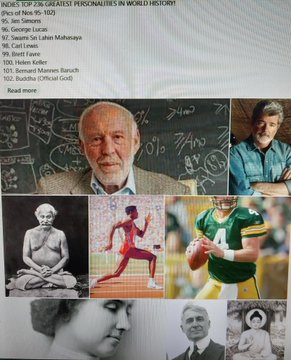
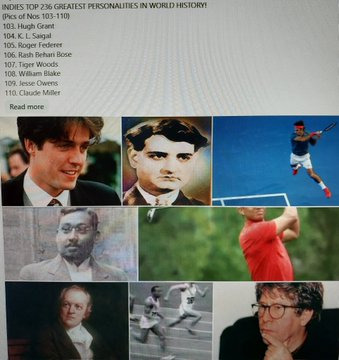
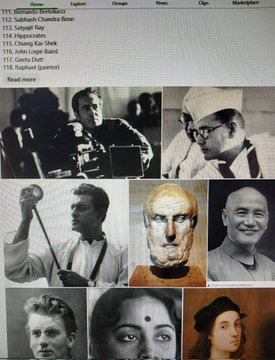

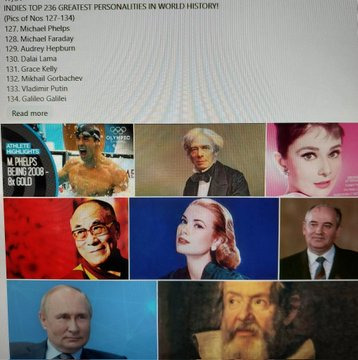

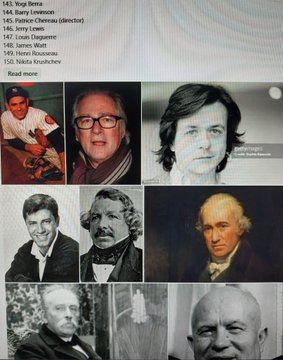
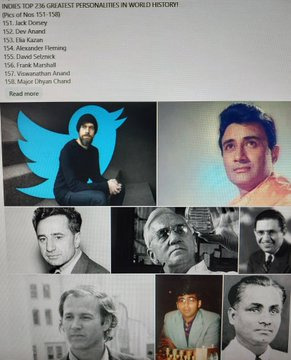
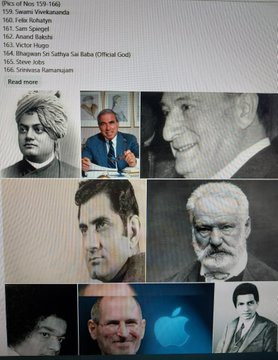
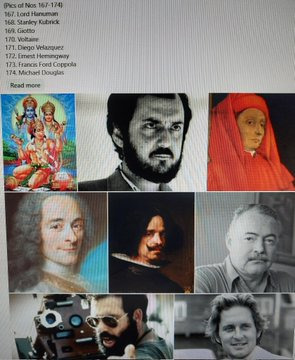
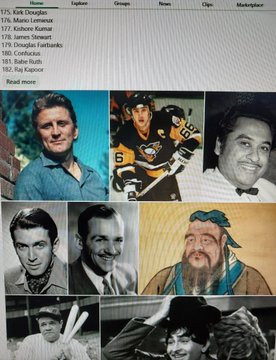
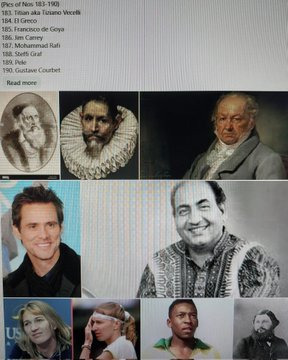
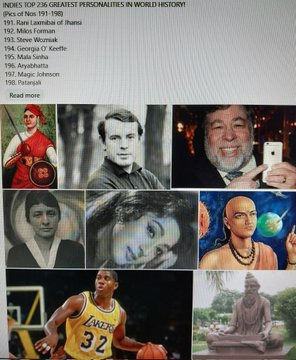
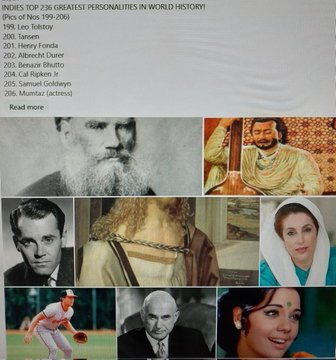

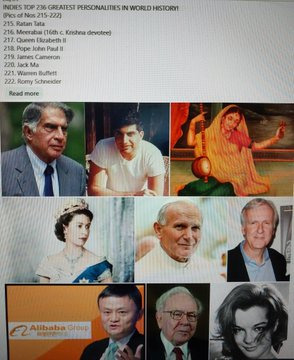

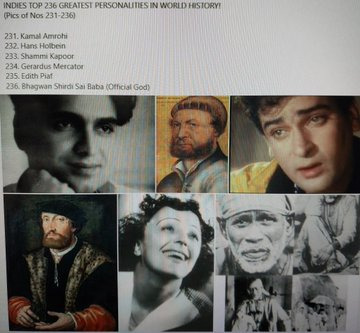
3 notes
·
View notes
Text
THE 236 GREATEST PERSONALITIES IN THE ENTIRE KNOWN HISTORY/COLLECTIVE CONSCIOUSNESS OF THIS WORLD! (@INDIES)
ie. THE 236 GREATEST PERSONALITIES IN WORLD HISTORY! (@INDIES)
Rajesh Khanna
Lionel Messi
Leonardo Da Vinci
Online Indie
Muhammad Ali
Joan of Arc
William Shakespeare
Vincent Van Gogh
J. K. Rowling
David Lean
Nadia Comaneci
Diego Maradona
Wolfgang Amadeus Mozart
Meena Kumari
Julius Caesar
Harrison Ford
Ludwig Van Beethoven
William W. Cargill
Fritz Hoffmann-La Roche
Samuel Curtis Johnson
Sam Walton
John D. Rockefeller
Andrew Carnegie
Roy Thomson
Tim Berners-Lee
Marie Curie
James J. Hill
Cornelius Vanderbilt
Roman Polanski
Samuel Slater
J. P. Morgan
Cary Grant
Dmitri Mendeleev
John Harvard
Alain Delon
Ramakrishna Paramhansa (Official God)
The Lumiere Brothers, Auguste & Louis
Carl Friedrich Benz
Michelangelo
Maharishi Mahesh Yogi
Ramana Maharishi
Mark Twain
Swami Sri Yukteswar Giri
Bruce Lee
Bhagwan Krishna (Official God)
Charlemagne
Rene Descartes
John F. Kennedy
Bhagwan Ganesha (Official God)
Walt Disney
Albert Einstein
Nikola Tesla
Alfred Hitchcock
Pythagoras
William Randolph Hearst
Cosimo de’ Medici
Johann Sebastian Bach
Alec Guinness
Nostradamus
Christopher Plummer
Archimedes
Jackie Chan
Guru Dutt
Amma Karunamayi/ Mata Parvati (Official God)
Peter Sellers
Gerard Depardieu
Joseph Safra
Robert Morris
Sean Connery
Petr Kellner
Aristotle Onassis
Usain Bolt
Jack Welch
Alfredo di Stefano
Elizabeth Taylor
Michael Jordan
Paul Muni
Steven Spielberg
Louis Pasteur
Ingrid Bergman
Norma Shearer
Dr. B. R. Ambedkar
Ayn Rand
Jesus Christ (Official God)
Luciano Pavarotti
Alain Resnais
Frank Sinatra
Allah (Official God)
Richard Nixon
Charlie Chaplin
Thomas Alva Edison
Alexander Graham Bell
Wright Brothers
Arjun (of Bhagwan Krishna’s Gita)
Jim Simons
George Lucas
Swami Sri Lahiri Mahasaya
Carl Lewis
Brett Favre
Helen Keller
Bernard Mannes Baruch
Buddha (Official God)
Hugh Grant
K. L. Saigal
Roger Federer
Rash Behari Bose
Tiger Woods
William Blake
Jesse Owens
Claude Miller
Bernardo Bertolucci
Subhash Chandra Bose
Satyajit Ray
Hippocrates
Chiang Kai-Shek
John Logie Baird
Geeta Dutt
Raphael (painter)
Bhagwan Shiva (Official God)
Radha (Ancient Krishna devotee)
George Orwell
Jorge Paulo Lemann
Catherine Deneuve
Pierre-Auguste Renoir
Bill Gates
Bhagwan Ram (Official God)
Michael Phelps
Michael Faraday
Audrey Hepburn
Dalai Lama
Grace Kelly
Mikhail Gorbachev
Vladimir Putin
Galileo Galilei
Gary Cooper
Roger Moore
John Huston
Blaise Pascal
Humphrey Bogart
Rudyard Kipling
Samuel Morse
Wayne Gretzky
Yogi Berra
Barry Levinson
Patrice Chereau (director)
Jerry Lewis
Louis Daguerre
James Watt
Henri Rousseau
Nikita Krushchev
Jack Dorsey
Dev Anand
Elia Kazan
Alexander Fleming
David Selznick
Frank Marshall
Viswanathan Anand
Major Dhyan Chand
Swami Vivekananda
Felix Rohatyn
Sam Spiegel
Anand Bakshi
Victor Hugo
Bhagwan Sri Sathya Sai Baba (Official God)
Steve Jobs
Srinivasa Ramanujam
Lord Hanuman
Stanley Kubrick
Giotto
Voltaire
Diego Velazquez
Ernest Hemingway
Francis Ford Coppola
Michael Douglas
Kirk Douglas
Mario Lemieux
Kishore Kumar
James Stewart
Douglas Fairbanks
Confucius
Babe Ruth
Raj Kapoor
Titian aka Tiziano Vecelli
El Greco
Francisco de Goya
Jim Carrey
Mohammad Rafi
Steffi Graf
Pele
Gustave Courbet
Rani Laxmibai of Jhansi
Milos Forman
Steve Wozniak
Georgia O’ Keeffe
Mala Sinha
Aryabhatta
Magic Johnson
Patanjali
Leo Tolstoy
Tansen
Henry Fonda
Albrecht Durer
Benazir Bhutto
Cal Ripken Jr
Samuel Goldwyn
Mumtaz (actress)
Panini
Nicolaus Copernicus
Pablo Picasso
George Clooney
Olivia de Havilland
Prem Chand
Imran Khan
Pete Sampras
Ratan Tata
Meerabai (16th c. Krishna devotee)
Queen Elizabeth II
Pope John Paul II
James Cameron
Jack Ma
Warren Buffett
Romy Schneider
C. V. Raman
Aung San Suu Kyi
Benjamin Netanyahu
Frank Capra
Michael Schumacher
Steve Forbes
Paramhansa Yogananda
Tom Hanks
Kamal Amrohi
Hans Holbein
Shammi Kapoor
Gerardus Mercator
Edith Piaf
Bhagwan Shirdi Sai Baba (Official God) .

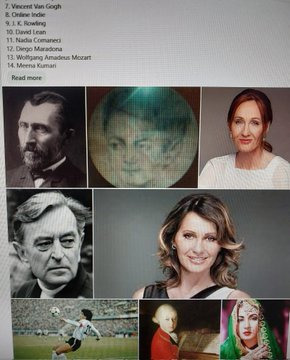
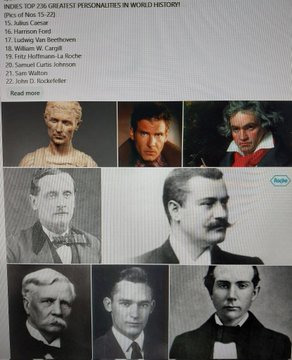
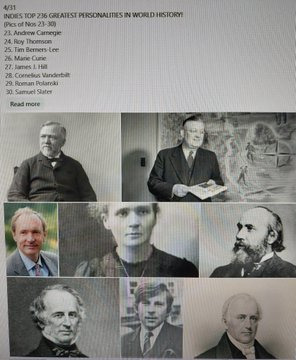
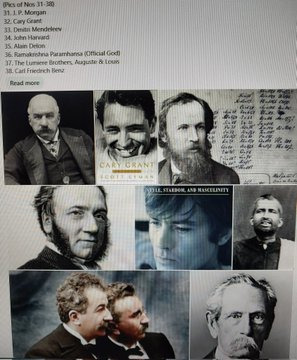




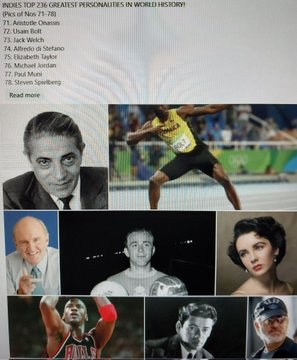
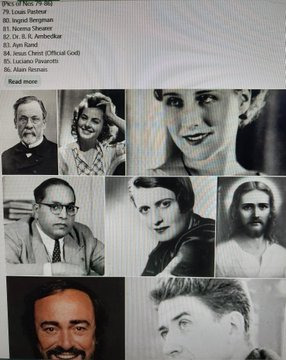
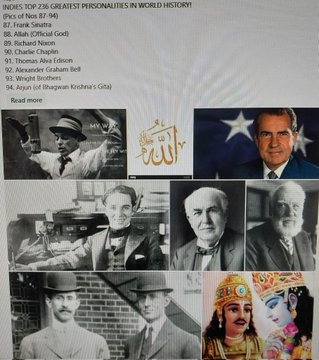


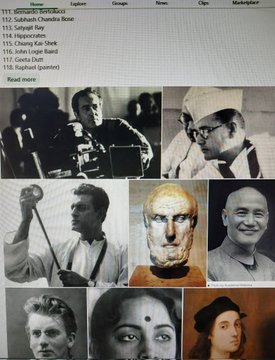


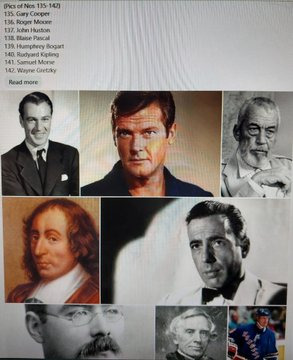
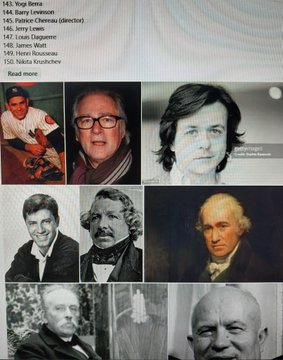


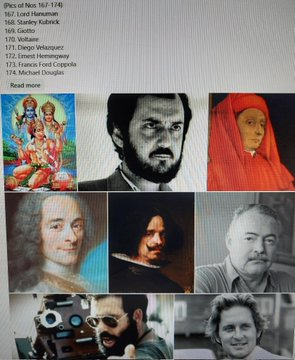

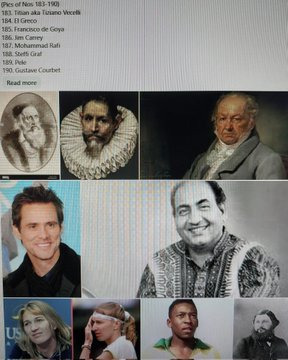
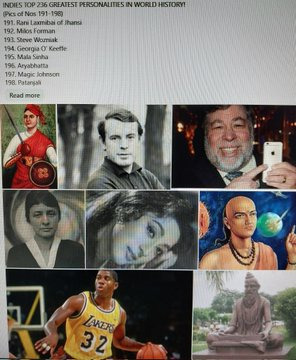
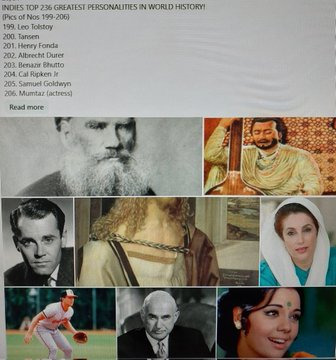
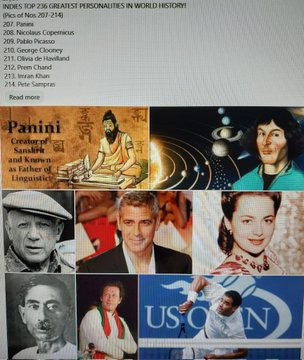
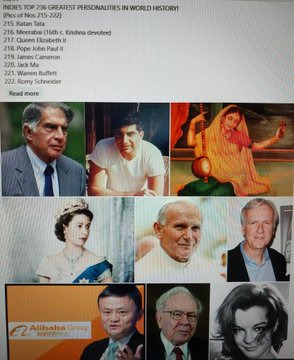
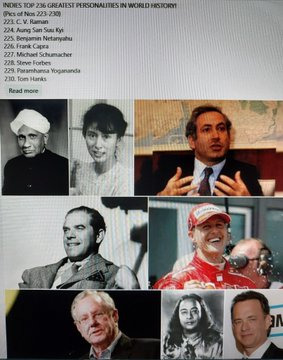
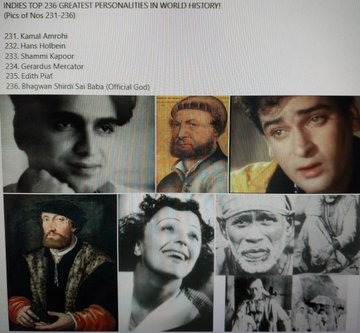
1 note
·
View note
Text
So we waited 6 episodes to see Adena for them to put her and kat in this mess.
Friends really 😒 for like two seconds.
No words for this episode they better make things work next episode

Also seeing Dana Fairbanks for the L word made me realize how much i miss that show.

45 notes
·
View notes
Text
9 Signs You Sell Uncle Drew Film For A Living
How The Important American Independent Movies Industry are Changing to Troubling Times
Table of ContentsThe top 11 things The Greatest American Independent Movies can help withWhy You Never Found Best Independent Films to Be ImportantWhy Independent Film are So PopularWhy The Greatest American Independent Movies are Booming
UA rented room at the Pickford/Fairbanks Workshop, but did not possess a workshop whole lot as such. Because of this, much of their movies would be fired on area. Mainly functioning as lenders, they supplied money to independent producers. Thus UA did not have the expenses, the maintenance or the expensive production personnel which added expenses at other workshops.
Levine as well as others. By the late 1950s, RKO had ceased film manufacturing, and the staying four of big 5 had identified that they did not recognize just how to reach the young people audience. In an effort to capture this target market, the Studios hired a host of young filmmakers (much of whom were mentored by Roger Corman) and also enabled them to make their films with reasonably little studio control.
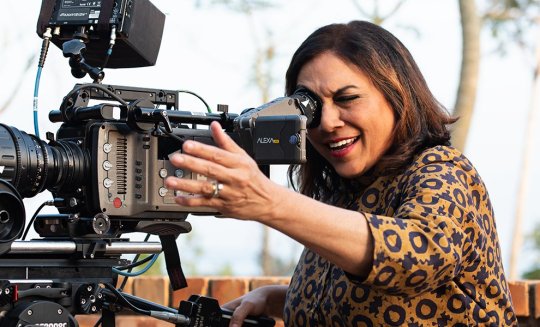
The only Sundance Film Festival Guide You'll Ever Need
The flick had actually earned over $70 million around the world by 1973. This preliminary successes led the means for the workshop to give up nearly full control to the movie institution generation and began what the media dubbed "New Hollywood." Dennis Hopper, the American actor, made his writing as well as routing debut with (1969 ).
Easy Biker debuted at Cannes as well as gathered the "Very first Film Award" (French: Prix de la premiere oeuvre) after which it received two Oscar elections, one for finest original screenplay as well as one for Corman-alum Jack Nicholson's innovation performance in the supporting function of George Hanson, an alcoholic legal representative for the American Civil Liberties Union.
21 You Always Wondered About Influential People In Independent Film
It came to be the initial and just X rated movie to win the Academy Award for finest picture. Midnight Cowboy likewise held the distinction of including cameo functions by much of the top Warhol superstars, who had actually currently become symbols of the militantly anti-Hollywood climate of NYC's independent film neighborhood. Within a month, one more young Corman student, Francis Ford Coppola, made his launching in Spain at the Donostia-San Sebastian International Film Event with (1969 ), a movie he had generated with his own firm, American Zoetrope.
Via Zoetrope, Coppola created a distribution contract with workshop huge Warner Bros., which he would exploit to achieve wide launches for his movies without making himself based on their control. These 3 movies provided the significant Hollywood workshops with both an instance to comply with and also a new plant of ability to draw from.
youtube
By the list below year, 2 Brand-new Hollywood supervisors had come to be sufficiently established for Coppola to be offered oversight of Paramount's (1972) as well as Lucas had acquired workshop funding for (1973) from Universal. In the mid-1970s, the significant Hollywood studios continued to touch these new filmmakers for both suggestions and workers, producing movies such as (1973) as well as (1976 ), all of which consulted with essential and commercial success.
While a lot of members of the New Hollywood generation were, or began as, independent filmmakers, a number of their tasks were created as well as released by major workshops. The New Hollywood generation soon came to be firmly set in a revived manifestation of the workshop system, which financed the development, manufacturing as well as distribution of their movies.
The Only Guide to Independent Filmmakers You're Going To Need
Relatively independent movies such as Cab driver, and others were workshop films: the manuscripts were based on studio pitches and consequently paid for by the studios, the production funding was from the studio, as well as the advertising and circulation of the films were designed and controlled by the studio's advertising firm.

Tips and Trick for Best Independent Films
Indeed, it was throughout this duration that the really definition of an independent film ended up being obscured. Though Midnight Cowboy was funded by United Artists, the business was certainly a workshop. Also, Zoetrope was another "independent workshop" which functioned within the system to make a space for independent directors who required funding.
In fact, the only two films of the motion which can be defined as uncompromisingly independent are Easy Cyclist at the start, and Peter Bogdanovich's, at the end. Peter Bogdanovich gotten back the rights from the workshop to his 1980 movie and also paid for its distribution out of his very own pocket, encouraged that the image was better than what the workshop believed he ultimately went bankrupt as a result of this.
With their unprecedented box-office successes, these flicks jump-started Hollywood's hit attitude, giving workshops a brand-new paradigm regarding exactly how to earn money in this altering business landscape. The focus on high-concept properties, with greater concentration on tie-in goods (such as playthings), spin-offs into various other media (such as soundtracks), and also making use of sequels (which had been made extra reputable by Coppola's ), all revealed the workshops how to earn money in the brand-new atmosphere.
6 things About independent filmmaking official statement Independent Film Directors That Will Change the Way You feel
At some point, even RKO was restored. The corporate mindset these companies offered the filmmaking business would slowly eject the a lot more distinctive of these young filmmakers, while seating the a lot more malleable and readily effective of them. Like the original independents that left the Edison Depend develop old Hollywood, the young film school graduates who had actually fled the workshops to explore on-location shooting and dynamic, neo-realist styles as well as frameworks ended up changing the autocrats they had actually looked for to dislodge with a more secure and also all-pervasive base of power.
Directors who wished to reach mainstream target markets of Old Hollywood swiftly discovered to stylise these styles to make their movies appealing and eye-catching as opposed to undesirable or profane. Nevertheless, at the exact same time that the radical movie trainees of the American New Wave were creating the abilities they would certainly make use of to take control of Hollywood, much of their peers had begun to develop their style of filmmaking in a various direction.
e. Joseph P. Mawra, Michael Findlay, as well as Henri Pachard) and avant-garde movie theater, (Kenneth Temper, Maya Deren) a variety of young movie manufacturers started to trying out transgression not as a box-office draw, yet as an artistic act. Supervisors such as John Waters and David Lynch would certainly go far for themselves by the early 1970s for the peculiar as well as often disturbing images which identified their films.
1 note
·
View note
Text
The Academy Awards through the years: PT. 1
By Los Angeles Times Staff
Feb. 26th, 2017
The first ceremony made the Los Angeles Times’ front page under the headline “Film-Merit Trophies Awarded.” Coverage was all of one photograph and two paragraphs. Since then, the Academy Awards have become an event watched around the world. Scroll down for a year-by-year look at the Oscars.
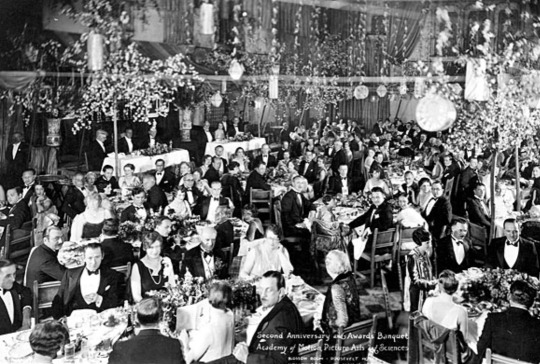
May 16, 1929. The first Academy Awards at the Hollywood Roosevelt's Blossom Room (Academy of Motion Picture Arts and Sciences)
Before a large gathering of motion-picture celebrities and other notables, the first Academy Awards ceremony is held at the Hollywood Roosevelt Hotel. Academy President Douglas Fairbanks handed out 15 statuettes for outstanding achievement in 1927 and 1928.
Best picture: “Wings”
Actor: Emil Jannings, “The Last Command” and “The Way of all Flesh”
Actress: Janet Gaynor, “Seventh Heaven,” “Street Angel” and “Sunrise”
Director: Frank Borzage, “Seventh Heaven”

April 3, 1930. "Broadway Melody" was released in 1929 and took top honors at the Academy Awards the next year. (MGM)
The Academy Awards are announced during a banquet attended by 300 academy members and their guests at the Ambassador Hotel. Academy President William C. deMille presents seven gold statuettes.
Best picture: “The Broadway Melody”
Actor: Warner Baxter, “In Old Arizona”
Actress: Mary Pickford, “Coquette”
Director: Frank Lloyd, “The Divine Lady”

Nov. 5, 1930. Norma Shearer with her statuette for "The Divorcee." (Associated Press)
Conrad Nagel, vice president of the Academy of Motion Picture Arts and Sciences, presents the statuettes at the third awards ceremony. The 600 attendees watch “Artistic and Otherwise,” a “sound recording film” by Thomas A. Edison on the industry’s progress in the last decade.
Best picture: “All Quiet on the Western Front”
Actor: George Arliss, “Disraeli”
Actress: Norma Shearer, “The Divorcee”
Director: Lewis Milestone, “All Quiet on the Western Front”

Nov. 10, 1931. Marie Dressler and Lionel Barrymore after their wins. (Associated Press)
The notables of Filmland gather at the Biltmore Hotel for the annual banquet. U.S. Vice President Charles Curtis tells the 2,000 gathered: “To my mind, the motion-picture industry is one of man’s greatest benefactors — it is great in size, in reputation and in worth.”
Best picture: “Cimarron”
Actor: Lionel Barrymore, “Free Soul”
Actress: Marie Dressler, “Min and Bill”
Director: Norman Taurog, “Skippy”
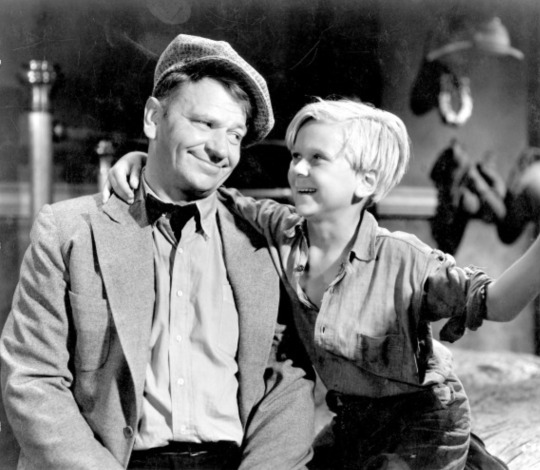
Nov. 18, 1932. Wallace Beery, left, and Jackie Cooper starred in "The Champ." (Academy of Motion Picture Arts and Sciences)
Lionel Barrymore is the toastmaster at the annual awards banquet at the Ambassador Hotel. Walt Disney is given a special award for his series of Mickey Mouse cartoons. As the ballots are turned in they are dropped into a special machine and tabulated “in full view of the assembled guests.”
Best picture: “Grand Hotel”
Actor: Fredric March, “Dr. Jekyll and Mr. Hyde” and Wallace Beery, “The Champ”
Actress: Helen Hayes, “The Sin of Madelon Claudet”
Director: Frank Borzage, “Bad Girl”

March 16, 1934. Douglas Fairbanks Jr. with Katharine Hepburn in a scene from "Morning Glory" (Associated Press)
Katharine Hepburn, still a newcomer to Hollywood, wins her first Academy Award for her work in “Morning Glory.” “Little Women,” in which she also stars, finishes third in the race for best production behind “A Farewell to Arms” and the winner, a film adaptation of playwright Noel Coward’s “Calvacade.”
Best picture: “Cavalcade”
Actor: Charles Laughton, “The Private Life of Henry VIII”
Actress: Katharine Hepburn, “Morning Glory”
Director: Frank Lloyd, “Cavalcade”
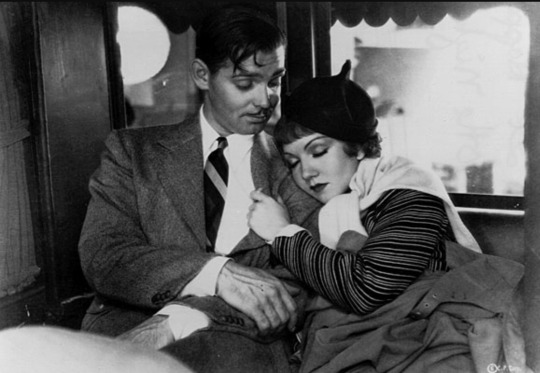
Feb. 27, 1935. Clark Gable and Claudette Colbert in "It Happened One Night." (Columbia Pictures)
The humorist Irvin S. Cobb presents the gold statuettes at the Biltmore Hotel. In “a radical departure from all previous elections,” the balloting is done in the open and write-ins are allowed. Although she doesn’t win, Bette Davis receives the most write-in votes for her work in “Of Human Bondage.”
Best picture: “It Happened One Night”
Actor: Clark Gable, “It Happened One Night”
Actress: Claudette Colbert, “It Happened One Night”
Director: Frank Capra, “It Happened One Night”
*Courtesy of Los Angeles Times.
#academy awards#old academy awards#vintage academy awards#old hollywood stars#old movies#old films#old hollywood#old cinema#vintagewomen#vintagephotos#vintagefashion#vintage hollywood#vintage films#vintage cinema#early academy awards#1920s#1920s hollywood#1920sfashion#1920s film#1920s history#1930smovies#1930sfashion#1930s hollywood#1930s#1930s cinema#1930s photography#los angeles times#clark gable#film-merit trophies awarded#hollywood roosevelt hotel
3 notes
·
View notes
Text

Mickey Rooney (born Ninnian Joseph Yule Jr.; September 23, 1920 – April 6, 2014) was an American actor, vaudevillian, comedian, producer and radio personality. In a career spanning nine decades and continuing until shortly before his death, he appeared in more than 300 films and was among the last surviving stars of the silent-film era.
At the height of a career that was marked by declines and comebacks, Rooney performed the role of Andy Hardy in a series of 16 films in the 1930's and 1940's that epitomized American family values. A versatile performer, he became a celebrated character actor later in his career. Laurence Olivier once said he considered Rooney "the best there has ever been". Clarence Brown, who directed him in two of his earliest dramatic roles, National Velvet and The Human Comedy, said he was "the closest thing to a genius I ever worked with".
Rooney first performed in vaudeville as a child and made his film debut at the age of six. At 14, he played Puck in the play and later the 1935 film adaptation of A Midsummer Night's Dream. Critic David Thomson hailed his performance as "one of the cinema's most arresting pieces of magic". In 1938, he co-starred in Boys Town. At 18, he was the first teenager to be nominated for an Oscar for his leading role in Babes in Arms, and he was awarded a special Academy Juvenile Award in 1939.[4] At the peak of his career between the ages of 15 and 25, he made 43 films, which made him one of Metro-Goldwyn-Mayer's most consistently successful actors and a favorite of MGM studio head Louis B. Mayer.
Rooney was the top box-office attraction from 1939 to 1941 and one of the best-paid actors of that era, but his career would never again rise to such heights. Drafted into the Army during World War II, he served nearly two years entertaining over two million troops on stage and radio and was awarded a Bronze Star for performing in combat zones. Returning from the war in 1945, he was too old for juvenile roles but too short to be an adult movie star, and was unable to get as many starring roles although there are numerous inexpensively made but critically well-received films noir with Rooney playing the lead during the post-war period and 1950s. Nevertheless, Rooney's popularity was renewed with well-received supporting roles in films such as Breakfast at Tiffany's (1961) with Audrey Hepburn, Requiem for a Heavyweight (1962) with Anthony Quinn and Jackie Gleason, It's a Mad, Mad, Mad, Mad World (1963), and The Black Stallion (1979). In the early 1980s, he returned to Broadway in Sugar Babies and again became a celebrated star. Rooney made hundreds of appearances on TV, including dramas, variety programs, and talk shows, and won an Emmy in 1982 plus a Golden Globe for his role in Bill (1981).
Rooney was born Ninnian Joseph Yule Jr. on September 23, 1920 in Brooklyn, New York, the only child of vaudevillians Nellie W. Carter, from Kansas City, Missouri and Joe Yule, a native of Glasgow, Scotland. His mother was a former chorus girl and a burlesque performer. When Rooney was born, his parents were appearing in a Brooklyn production of A Gaiety Girl. Rooney later recounted in his memoirs that he began performing at the age of 17 months as part of his parents' routine, wearing a specially tailored tuxedo.
Rooney's parents separated when he was four years old in 1924, and he and his mother moved to Hollywood the following year from Greenpoint, Brooklyn. He made his first film appearance at age six in 1926, in the short Not to be Trusted. Rooney got bit parts in films such as The Beast of the City (1932) and The Life of Jimmy Dolan (1933), which allowed him to work alongside stars such as Joel McCrea, Colleen Moore, Clark Gable, Douglas Fairbanks Jr., John Wayne and Jean Harlow. He enrolled in the Hollywood Professional School and later attended Hollywood High School, graduating in 1938.
His mother saw an advertisement for a child to play the role of "Mickey McGuire" in a series of short films. Rooney got the role and became "Mickey" for 78 of the films, running from 1927 to 1936, starting with Mickey's Circus (1927), his first starring role. During this period, he also briefly voiced Oswald the Lucky Rabbit. He made other films in his adolescence, including several more of the McGuire films. At age 14, he played the role of Puck in the Warner Brothers all-star adaptation of A Midsummer Night's Dream in 1935. Rooney then moved to MGM, where he befriended Judy Garland, with whom he began making a series of musicals that propelled both of them to stardom.
In 1937, Rooney was selected to portray Andy Hardy in A Family Affair, which MGM had planned as a B-movie.[14] Rooney provided comic relief as the son of Judge James K. Hardy, portrayed by Lionel Barrymore (although former silent film leading man Lewis Stone played the role of Judge Hardy in subsequent pictures). The film was an unexpected success, and led to 13 more Andy Hardy films between 1937 and 1946, and a final film in 1958.
According to author Barry Monush, MGM wanted the Andy Hardy films to appeal to all family members. Rooney's character portrayed a typical "anxious, hyperactive, girl-crazy teenager", and he soon became the unintended main star of the films. Although some critics describe the series of films as "sweet, overly idealized, and pretty much interchangeable," their ultimate success was because they gave viewers a "comforting portrait of small-town America that seemed suited for the times", with Rooney instilling "a lasting image of what every parent wished their teen could be like".
Behind the scenes, however, Rooney was like the "hyperactive girl-crazy teenager" he portrayed on the screen. Wallace Beery, his co-star in Stablemates, described him as a "brat", but a "fine actor". MGM head Louis B. Mayer found it necessary to manage Rooney's public image, explains historian Jane Ellen Wayne:
Mayer naturally tried to keep all his child actors in line, like any father figure. After one such episode, Mickey Rooney replied, "I won't do it. You're asking the impossible." Mayer then grabbed young Rooney by his lapels and said, "Listen to me! I don't care what you do in private. Just don't do it in public. In public, behave. Your fans expect it. You're Andy Hardy! You're the United States! You're the Stars and Stripes. Behave yourself! You're a symbol!" Mickey nodded. "I'll be good, Mr. Mayer. I promise you that." Mayer let go of his lapels, "All right," he said.
Fifty years later, Rooney realized in hindsight that these early confrontations with Mayer were necessary for him to develop into a leading film star: "Everybody butted heads with him, but he listened and you listened. And then you'd come to an agreement you could both live with. ... He visited the sets, he gave people talks ... What he wanted was something that was American, presented in a cosmopolitan manner."
In 1937, Rooney made his first film alongside Judy Garland with Thoroughbreds Don't Cry. Garland and Rooney became close friends as they co-starred in future films and became a successful song-and-dance team. Audiences delighted in seeing the "playful interactions between the two stars showcase a wonderful chemistry".[27] Along with three of the Andy Hardy films, where she portrayed a girl attracted to Andy, they appeared together in a string of successful musicals, including Babes in Arms (1939). During an interview in the 1992 documentary film MGM: When the Lion Roars, Rooney describes their friendship:[28]
Judy and I were so close we could've come from the same womb. We weren't like brothers or sisters but there was no love affair there; there was more than a love affair. It's very, very difficult to explain the depths of our love for each other. It was so special. It was a forever love. Judy, as we speak, has not passed away. She's always with me in every heartbeat of my body.
In 1937, Rooney received top billing as Shockey Carter in Hoosier Schoolboy but his breakthrough-role as a dramatic actor came in 1938's Boys Town opposite Spencer Tracy as Father Flanagan, who runs a home for wayward and homeless boys. Rooney was awarded a special Juvenile Academy Award in 1939, for "significant contribution in bringing to the screen the spirit and personification of youth". Wayne describes one of the "most famous scenes" in the film, where tough young Rooney is playing poker with a cigarette in his mouth, his hat is cocked and his feet are up on the table. "Tracy grabs him by the lapels, throws the cigarette away and pushes him into a chair. 'That's better,' he tells Mickey." Louis B. Mayer said Boys Town was his favorite film during his years at MGM.
The popularity of his films made Rooney the biggest box-office draw in 1939, 1940 and 1941. For their roles in Boys Town, Rooney and Tracy won first and second place in the Motion Picture Herald 1940 National Poll of Exhibitors, based on the box office appeal of 200 players. Boys' Life magazine wrote, "Congratulations to Messrs. Rooney and Tracy! Also to Metro-Goldwyn-Mayer we extend a hearty thanks for their very considerable part in this outstanding achievement." Actor Laurence Olivier once called Rooney "the greatest actor of them all".
A major star in the early 1940s, he appeared on the cover of Time magazine in 1940, timed to coincide with the release of Young Tom Edison; the cover story began:
Hollywood's No. 1 box office bait in 1939 was not Clark Gable, Errol Flynn or Tyrone Power, but a rope-haired, kazoo-voiced kid with a comic-strip face, who until this week had never appeared in a picture without mugging or overacting it. His name (assumed) was Mickey Rooney, and to a large part of the more articulate U.S. cinema audience, his name was becoming a frequently used synonym for brat.
During his long and illustrious career, Rooney also worked with many of the screen's female stars, including Elizabeth Taylor in National Velvet (1944) and Audrey Hepburn in Breakfast at Tiffany's (1961)." With his appearing with Marilyn Monroe in The Fireball (1950) and with Grace Kelly in The Bridges at Toko-Ri (1954), Rooney is the only actor ever co-starring with four of the greatest female screen legends ever. Rooney's "bumptiousness and boyish charm" as an actor developed more "smoothness and polish" over the years, writes biographer Scott Eyman. The fact that Rooney fully enjoyed his life as an actor played a large role in those changes:
You weren't going to work, you were going to have fun. It was home, everybody was cohesive; it was family. One year I made nine pictures; I had to go from one set to another. It was like I was on a conveyor belt. You did not read a script and say, "I guess I'll do it." You did it. They had people that knew the kind of stories that were suited to you. It was a conveyor belt that made motion pictures.
Clarence Brown, who directed Rooney in his Oscar-nominated performance in The Human Comedy (1943) and again in National Velvet (1944), enjoyed working with Rooney in films:
Mickey Rooney is the closest thing to a genius that I ever worked with. There was Chaplin, then there was Rooney. The little bastard could do no wrong in my book ... All you had to do with him was rehearse it once.
In June 1944, Rooney was inducted into the United States Army, where he served more than 21 months (until shortly after the end of World War II) entertaining the troops in America and Europe in Special Services. He spent part of the time as a radio personality on the American Forces Network and was awarded the Bronze Star Medal for entertaining troops in combat zones. In addition to the Bronze Star Medal, Rooney also received the Army Good Conduct Medal, American Campaign Medal, European-African-Middle Eastern Campaign Medal, and World War II Victory Medal, for his military service.
Rooney's career slumped after his return to civilian life. He was now an adult with a height of only 5 feet 2 inches (1.57 m) and he could no longer play the role of a teenager, but he also lacked the stature of most leading men. He appeared in a number of films, including Words and Music in 1948, which paired him for the last time with Garland on film (he appeared with her on one episode as a guest on The Judy Garland Show). He briefly starred in a CBS radio series, Shorty Bell, in the summer of 1948, and reprised his role as "Andy Hardy", with most of the original cast, in a syndicated radio version of The Hardy Family in 1949 and 1950 (repeated on Mutual during 1952).
In 1949 Variety reported that Rooney had renegotiated his deal with MGM. He agreed to make one film a year for them for five years at $25,000 a movie (his fee until then had been $100,000 but Rooney wanted to enter independent production.) Rooney claimed he was unhappy with the billing MGM gave him for Words and Music.
His first television series, The Mickey Rooney Show, also known as Hey, Mulligan, was created by Blake Edwards with Rooney as his own producer, and appeared on NBC television for 32 episodes between August 28, 1954 and June 4, 1955.[46] In 1951, he made his directorial debut with My True Story, starring Helen Walker.[47] Rooney also starred as a ragingly egomaniacal television comedian, loosely based on Red Buttons, in the live 90-minute television drama The Comedian, in the Playhouse 90 series on the evening of Valentine's Day in 1957, and as himself in a revue called The Musical Revue of 1959 based on the 1929 film The Hollywood Revue of 1929, which was edited into a film in 1960.
In 1958, Rooney joined Dean Martin and Frank Sinatra in hosting an episode of NBC's short-lived Club Oasis comedy and variety show. In 1960, Rooney directed and starred in The Private Lives of Adam and Eve, an ambitious comedy known for its multiple flashbacks and many cameos. In the 1960s, Rooney returned to theatrical entertainment. He still accepted film roles in undistinguished films but occasionally appeared in better works, such as Requiem for a Heavyweight (1962) and It's a Mad, Mad, Mad, Mad World (1963).
He portrayed a Japanese character, Mr. Yunioshi, in the 1961 film version of Truman Capote's novella Breakfast at Tiffany's. His performance was criticized by some in subsequent years as a racist stereotype. Rooney later said that he would not have taken the role if he had known it would offend people.
On December 31, 1961, Rooney appeared on television's What's My Line and mentioned that he had already started enrolling students in the MRSE (Mickey Rooney School of Entertainment). His school venture never came to fruition. This was a period of professional distress for Rooney; as a childhood friend, director Richard Quine put it: "Let's face it. It wasn't all that easy to find roles for a 5-foot-3 man who'd passed the age of Andy Hardy." In 1962, his debts had forced him into filing for bankruptcy.
In 1966, Rooney was working on the film Ambush Bay in the Philippines when his wife Barbara Ann Thomason— a former model and aspiring actress who had won 17 straight beauty contests in Southern California—was found dead in her bed. Her lover, Milos Milos—who was one of Rooney's actor-friends—was found dead beside her. Detectives ruled it a murder-suicide, which was committed with Rooney's own gun.
Francis Ford Coppola had bought the rights to make The Black Stallion (1979), and when casting it, he called Rooney and asked him if he thought he could play a jockey. Rooney replied saying, "Gee, I don't know. I never played a jockey before." He was kidding, he said, since he had played a jockey in at least three past films, including Down the Stretch, Thoroughbreds Don't Cry, and National Velvet. The film garnered excellent reviews and earned $40 million in its first run, which gave Coppola's struggling studio, American Zoetrope, a major boost. It also gave Rooney newfound recognition, along with a nomination for Best Supporting Actor.
In 1983, the Academy of Motion Picture Arts and Sciences gave Rooney their Academy Honorary Award for his lifetime of achievement.
In addition to his movie roles, Rooney made numerous guest-starring roles as a television character actor for nearly six decades, beginning with an episode of Celanese Theatre. The part led to other roles on such television series as Schlitz Playhouse, Playhouse 90, Producers' Showcase, Alcoa Theatre, The Soldiers, Wagon Train, General Electric Theater, Hennesey, The Dick Powell Theatre, Arrest and Trial (1964), Burke's Law (1963), Combat! (1964), The Fugitive, Bob Hope Presents the Chrysler Theatre, The Jean Arthur Show (1966), The Name of the Game (1970), Dan August (1970), Night Gallery (1970)
In 1961, he guest-starred in the 13-week James Franciscus adventure–drama CBS television series The Investigators. In 1962, he was cast as himself in the episode "The Top Banana" of the CBS sitcom, Pete and Gladys, starring Harry Morgan and Cara Williams.
In 1963, he entered CBS's The Twilight Zone, giving a one-man performance in the episode "The Last Night of a Jockey" (1963). Also in 1963, in 'The Hunt' for Suspense Theater, he played the sadistic sheriff hunting the young surfer played by James Caan. In 1964, he launched another half-hour sitcom, Mickey. The story line had "Mickey" operating a resort hotel in southern California. His own son Tim Rooney appeared as his character's teenage son on this program, and Emmaline Henry starred as Rooney's wife. The program lasted for 17 episodes.
When Norman Lear was developing All in the Family in 1970, he wanted Rooney for the lead role of Archie Bunker.[66] Rooney turned Lear down; and the role eventually went to Carroll O'Connor.
Rooney garnered a Golden Globe and an Emmy Award for Outstanding Lead Actor in a Limited Series or a Special for his role in 1981's Bill. Playing opposite Dennis Quaid, Rooney's character was a mentally handicapped man attempting to live on his own after leaving an institution. His acting quality in the film has been favorably compared to other actors who took on similar roles, including Sean Penn, Dustin Hoffman and Tom Hanks. He reprised his role in 1983's Bill: On His Own, earning an Emmy nomination for the turn.
Rooney did voice acting from time to time. He provided the voice of Santa Claus in four stop-motion animated Christmas TV specials: Santa Claus Is Comin' to Town (1970), The Year Without a Santa Claus (1974), Rudolph and Frosty's Christmas in July (1979) and A Miser Brothers' Christmas (2008). In 1995, he appeared as himself on The Simpsons episode "Radioactive Man".
After starring in one unsuccessful TV series and turning down an offer for a huge TV series, Rooney, now 70, starred in the Family Channel's The Adventures of the Black Stallion, where he reprised his role as Henry Dailey in the film of the same name, eleven years earlier. The series ran for three years and was an international hit.
Rooney appeared in television commercials for Garden State Life Insurance Company in 2002.
A major turning point came in 1979, when Rooney made his Broadway debut in the acclaimed stage play Sugar Babies, a musical revue tribute to the burlesque era costarring former MGM dancing star Ann Miller. Aljean Harmetz noted that "Mr. Rooney fought over every skit and argued over every song and almost always got things done his way. The show opened on Broadway on October 8, 1979, to rave reviews, and this time he did not throw success away. Rooney and Miller performed the show 1,208 times in New York and then toured with it for five years, including eight months in London. Co-star Miller recalls that Rooney "never missed a performance or a chance to ad-lib or read the lines the same way twice, if he even stuck to the script". Biographer Alvin Marill states that "at 59, Mickey Rooney was reincarnated as a baggy-pants comedian—back as a top banana in show biz in his belated Broadway debut."
Following this, he toured as Pseudelous in Stephen Sondheim's A Funny Thing Happened on the Way to the Forum. In the 1990s, he returned to Broadway for the final months of Will Rogers Follies, playing the ghost of Will's father. On television, he starred in the short-lived sitcom, One of the Boys, along with two unfamiliar young stars, Dana Carvey and Nathan Lane, in 1982.
He toured Canada in a dinner theatre production of The Mind with the Naughty Man in the mid-1990s. He played The Wizard in a stage production of The Wizard of Oz with Eartha Kitt at Madison Square Garden. Kitt was later replaced by Jo Anne Worley.
Rooney wrote a memoir titled Life is Too Short, published by Villard Books in 1991. A Library Journal review said that "From title to the last line, 'I'll have a short bier', Rooney's self-deprecating humor powers this book." He wrote a novel about a child star, published in 1994, The Search For Sunny Skies.
Despite the millions of dollars that he earned over the years, such as his $65,000 a week earnings from Sugar Babies, Rooney was plagued by financial problems late in life. His longtime gambling habit caused him to "gamble away his fortune again and again". He declared bankruptcy for the second time in 1996 and described himself as "broke" in 2005. He kept performing on stage and in the movies, but his personal property was valued at only $18,000 when he died in 2014.
Rooney and his wife Jan toured the country in 2005 through 2011 in a musical revue called Let's Put on a Show. Vanity Fair called it "a homespun affair full of dog-eared jokes" that featured Rooney singing George Gershwin songs.
In 2006, Rooney played Gus in Night at the Museum. He returned to play the role again in the sequel Night at the Museum: Battle of the Smithsonian in 2009, in a scene that was deleted from the final film.
On May 26, 2007, he was grand marshal at the Garden Grove Strawberry Festival. Rooney made his British pantomime debut, playing Baron Hardup in Cinderella, at the Sunderland Empire Theatre over the 2007 Christmas period, a role he reprised at Bristol Hippodrome in 2008 and at the Milton Keynes theatre in 2009.
In 2011, Rooney made a cameo appearance in The Muppets and in 2014, at age 93, he reprised his role as Gus in Night at the Museum: Secret of the Tomb, which was dedicated to him and to Robin Williams, who also died that year. Although confined to a wheelchair, he was described by director Shawn Levy as "energetic and so pleased to be there. He was just happy to be invited to the party."
An October 2015 article in The Hollywood Reporter maintained that Rooney was frequently abused and financially depleted by his closest relatives in the last years of his life. The article said that it was clear that "one of the biggest stars of all time, who remained aloft longer than anyone in Hollywood history, was in the end brought down by those closest to him. He died humiliated and betrayed, nearly broke and often broken." Rooney suffered from bipolar disorder and had attempted suicide two or three times over the years, with resulting hospitalizations reported as "nervous breakdowns".
At the time of his death, he was married to Jan Chamberlin Rooney, although they had separated in June 2012. He had nine children and two stepchildren, as well as 19 grandchildren and several great-grandchildren. Rooney had been addicted to sleeping pills, and overcame the sleeping pill addiction in 2000 when he was in his late 70s.
In the late 1970s, Rooney became a born-again Christian and was a fan of Pat Robertson.
In 1997, Rooney was arrested on suspicion of beating his wife, Jan, but charges were dropped due to lack of evidence.
On February 16, 2011, Rooney was granted a temporary restraining order against stepson Christopher Aber and Aber's wife, Christina, and they were ordered to stay 100 yards from Rooney, his stepson Mark Rooney and Mark's wife, Charlene Rooney. Rooney claimed that he was a victim of elder abuse.
On March 2, 2011, Rooney appeared before a special U.S. Senate committee that was considering legislation to curb elder abuse, testifying about the abuse he claimed to have suffered at the hands of family members. In 2011, all of Rooney's finances were permanently handed over to a conservator, who called Rooney "completely competent".
In April 2011, the temporary restraining order that Rooney was previously granted was replaced by a confidential settlement between Rooney and his stepson, Aber. Christopher Aber and Jan Rooney denied all the allegations.
In May 2013, Rooney sold his home of many years, reportedly for $1.3 million, and split the proceeds with his wife, Jan.
Rooney was married eight times, with six of the marriages ending in divorce. In 1942, he married his first wife, actress Ava Gardner, who at that time was still an obscure teenage starlet. They divorced the following year, partly because he had apparently been unfaithful. While stationed in the military in Alabama in 1944, Rooney met and married Betty Jane Phillips, who later became a singer under the name B.J. Baker. They had two sons together. This marriage ended in divorce after he returned from Europe at the end of World War II. His marriage to actress Martha Vickers in 1949 produced one son but ended in divorce in 1951. He married actress Elaine Mahnken in 1952 and they divorced in 1958.
In 1958, Rooney married model-actress Barbara Ann Thomason. She was murdered in 1966 by stuntman and actor Milos Milos, who then shot himself. Thomason and Milos had an affair while Rooney was traveling, and police theorized Milos shot her after she wanted to break off the affair. Rooney then married Barbara's best friend, Marge Lane. That marriage lasted 100 days.
He was married to Carolyn Hockett from 1969 to 1975. In 1978, Rooney married his eighth and final wife, Jan Chamberlin. Their marriage lasted until his death, a total of 34 years (longer than his seven previous unions combined), although they separated in 2012.
Rooney died on April 6, 2014 of natural causes, including complications from diabetes, in Los Angeles at the age of 93. A group of family members and friends, including Mickey Rourke, held a memorial service on April 18. A private funeral, organized by another set of family members, was held at Hollywood Forever Cemetery, where he was interred, on April 19. His eight surviving children said in a statement that they were barred from seeing Rooney during his final years.
At his death, Vanity Fair called him "the original Hollywood train wreck". He struggled with alcohol and pill addiction. Ava Gardner was his first wife, and he married an additional seven times. Despite earning millions during his career, he had to file for bankruptcy in 1962 due to mismanagement of his finances. Shortly before his death in 2014 at age 93, he accused some family members of mistreatment and testified before Congress about what he said was physical abuse and exploitation by family members. By the end of his life, his millions in earnings had dwindled to an estate that was valued at only $18,000. He died owing medical bills and back taxes, and contributions were solicited from the public.
Rooney was one of the last surviving actors of the silent film era. His film career spanned 88 years, from 1926 to 2014, continuing until shortly before his death. During his peak years from the late 1930s to the early 1940s, Rooney was among the top box-office stars in the United States.
He made forty-three pictures between the age of 15 and 25. Among those, his role as Andy Hardy became one of "Hollywood's best-loved characters," with Marlon Brando calling him "the best actor in films".
"There was nothing he couldn't do", said actress Margaret O'Brien.[109] MGM boss Louis B. Mayer treated him like a son and saw in Rooney "the embodiment of the amiable American boy who stands for family, humbug, and sentiment," writes critic and author, David Thomson.
By the time Rooney was 20, his consistent portrayals of characters with youth and energy suggested that his future success was unlimited. Thomson also explains that Rooney's characters were able to cover a wide range of emotional types, and gives three examples where "Rooney is not just an actor of genius, but an artist able to maintain a stylized commentary on the demon impulse of the small, belligerent man:"
Rooney's Puck in A Midsummer Night's Dream (1935) is truly inhuman, one of cinema's most arresting pieces of magic. ... His toughie in Boys Town (1938) struts and bullies like something out of a nightmare and then comes clean in a grotesque but utterly frank outburst of sentimentality in which he aspires to the boy community ... His role as Baby Face Nelson (1957), the manic, destructive response of the runt against a pig society.
By the end of the 1940s, Rooney's movie characters were no longer in demand and his career went downhill. "In 1938," he said, "I starred in eight pictures. In 1948 and 1949 together, I starred in only three." However, film historian Jeanine Basinger notes that although his career "reached the heights and plunged to the depths, Rooney kept on working and growing, the mark of a professional." Some of the films which reinvigorated his popularity, were Requiem for a Heavyweight (1962), It's a Mad, Mad, Mad, Mad World (1963) and The Black Stallion (1979). In the early 1980s, he returned to Broadway in Sugar Babies, and "found himself once more back on top".
Basinger tries to encapsulate Rooney's career:
Rooney's abundant talent, like his film image, might seem like a metaphor for America: a seemingly endless supply of natural resources that could never dry up, but which, it turned out, could be ruined by excessive use and abuse, by arrogance or power, and which had to be carefully tended to be returned to full capacity. From child star to character actor, from movie shorts to television specials, and from films to Broadway, Rooney ultimately did prove he could do it all, do it well, and keep on doing it. His is a unique career, both for its versatility and its longevity.
#mickey rooney#classic hollywood#golden age of hollywood#classic movie stars#old hollywood#silent era#silent stars#classic cinema#silent cinema
2 notes
·
View notes
Text
D. W. GRIFFITH: EL RACISTA QUE DESARROLLÓ EL LENGUAJE CINEMATOGRÁFICO


FAIRBANKS, PICKFORD, CHAPLIN Y GRIFFITH CUANDO CREARON UNITED ARTIST











Si realizamos un somero recorrido por las artes encontraremos auténticos genios que vivieron insertados en personalidades discutibles y en algunos casos muy contradictorias: Pío Baroja en la literatura, Caravaggio en la pintura o Riefenstahl en el cine, por solo citar unos ejemplos. Nuestro personaje de hoy fue un elemento tan genial como innovador para el arte que pocos años antes había nacido, pero al mismo tiempo fue un grosero reaccionario y un racista de enciclopedia: David Wark Griffith.
Se suele decir que los Lumiére (Edison en USA) inventaron la cámara, Meliés los efectos especiales, Alice Guy la dirección, Pathé la industria y que Eisenstein desarrolló el montaje, pero para muchos, quien realmente inventó el lenguaje cinematográfico fue el citado David W. Griffith (hasta la llegada de Orson Welles que introdujo las bases del cine moderno). Al igual que la literatura, el cine es producto de un lenguaje y de unas reglas que se fueron creando en sus primeros años.
Vamos a analizar el personaje, su obra y sus innovaciones cinematográficas.
EL PERSONAJE:
El estadounidense David W. Griffith nació en 1875 en el seno de una familia sureña, racista y esclavista (su padre luchó en el ejército confederado). Quiso ser escritor, pero fracasó y pronto se acercó al teatro y al cine como actor utilizando seudónimos para que su madre no se avergonzara de él y es que los cómicos siempre han tenido muy mala fama entre las clases más conservadoras. Entre 1908 y 1913 trabajó para la compañía AMB y comenzó a realizar sus primeros filmes ya como director obteniendo grandes éxitos entre 1915 y 1920. En el año 1919 se unió a Charles Chaplin, Douglas Fairbanks y Mary Pickford para fundar la United Artists y de esa forma salvaguardar su independencia creadora de los productores e inversores.
Griffith fue uno de los damnificados por la llegada del sonoro; no llegó a entender las nuevas posibilidades que se abrían con el sonido y solo logró dirigir dos películas sonoras.
Como una más de esas injusticias históricas, Griffith fue olvidado por la industria que él había ayudado a transformar en arte. Los últimos años de su vida estuvo al margen del cine, sumido en el alcohol y la soledad. En 1948 falleció como consecuencia de una hemorragia cerebral. Pocos famosos acudieron a su entierro a excepción de Lillian Gish (la gran actriz que Griffith había transformado en estrella) y Charles Chaplin; tan solo éste tuvo unas palabras para destacar la influencia de Griffith en el cine: “Ha sido el maestro de todos nosotros”.
SUS PELÍCULAS:
La historia del cine no se puede comprender sin destacar la aportación de Griffith. Fue autor de más de 500 películas (muchas desaparecidas). Su carrera se extendió desde 1908 (Las aventuras de Dollie) hasta 1931 (The struggle) y solo las dos últimas fueron sonoras.
Entre sus películas destacan:
1914: Judith de Bethulia
1915: El nacimiento de una nación: considerada por muchos como el origen del lenguaje cinematográfico. Interpretada por su actriz fetiche, Lillian Gish, es la obra maestra de Griffith y desgraciadamente reúne en ella todo lo bueno y lo malo de este genio del cine: aparecen en ella las aportaciones que el director estaba haciendo al lenguaje y al mismo tiempo es una grosera muestra de racismo (glorifica al Ku Klux Klan). Desdeñó utilizar actores negros pues esos papeles los interpretaron blancos con las caras pintadas. Narra la historia de la formación de los Estados Unidos y fue un éxito enorme con beneficios de más de 20 millones de dólares de la época.
1916: Intolerancia: un año después, Griffith cambia de registro y se embarca en contar varios episodios que muestran la intolerancia social y religiosa a lo largo de la historia. De nuevo con Lillian Gish, la película es de un despliegue espectacular y quien no la haya visto que al menos recale durante algunos minutos en YouTube y vea algunas de las asombrosas escenas con más de 15.000 extras que montó el director hace más de 100 años. Lo que a día de hoy llama más la atención es que una película tan racista como El nacimiento de una nación tuviese un éxito colosal, mientras que una película que predicaba la tolerancia y la comprensión entre los hombres fuese un fracaso de público (Griffith estuvo pagando deudas de la película hasta 1923).
1919: Lirios rotos: otro cambio total y también con Gish. Griffith realiza una película romántica minimalista en la que denuncia el maltrato a los hijos. Otra enorme obra maestra.
1922: Las dos huérfanas
1923: Flor que renace
1924: América
1925: Crimen y castigo
1929: La melodía del amor
1930: Abraham Lincoln (sonora)
1931: The Struggle (sonora)
SUS INNOVACIONES:
Posiblemente por sus películas y por el descubrimiento de las grandes estrellas de esa época como Lillian Gish o Mary Pickford, el nombre de Griffith ya habría pasado con letras de oro a la historia del cine, pero su aportación fue mucho mayor y aunque ese apelativo de los primeros historiadores como “padre del cine” pueda sonar excesivo es cierto que muchas de las claves que nos hacen comprender y entender la narración cinematográfica son creación del personaje que nos ocupa hoy. Veámoslo.
Sin duda la gran aportación de Griffith al cine fue la introducción generalizada del llamado Modo de Representación Institucional. Los primeros años del cine y su forma de expresión correspondió a lo que los historiadores han llamado Modo de Representación Primitiva básicamente originado por los Lumiére. Un cine teatralizado con la cámara fija y planos de escasa duración pues técnicamente no era posible que duraran más allá de unas decenas de segundos; era el lenguaje más primitivo de esta nueva forma de expresión que era el cine. Pero pasados unos años, creadores como Meliés o Alice Guy van introduciendo nuevas formas de expresión en sus películas, gracias también a mejoras de tipo técnico; la aparición de la escuela de Brighton inglesa hizo que se modificaran, se ampliasen y se fuesen consolidando esas innovaciones en diferentes películas de corta duración. Griffith en El nacimiento de una nación las recoge, las reúne e introduce nuevas formas expresivas. Esa fue la gran aportación de director norteamericano, dando lugar a la consolidación del Modo de Representación Institucional que, esencialmente, es el que ha llegado hasta nosotros.
¿Cuáles fueron esencialmente esas innovaciones que reunió Griffith en sus obras?
-el principio de simetría: repeticiones de plano a lo largo de la narración o repetición del plano final idéntico al plano inicial.
-el fuera de campo: el espacio fuera de la cámara también debe ser comprensible para que el espectador siga la narración.
-la profundidad de campo: no solo visual sino también narrativa (en esto Woody Allen y Berlanga han sido unos maestros).
-el cine con cámara inmóvil (fotografía o teatro animado) que tomaba un Plano General de la escena sin cambio alguno se asienta con Griffith en los cambios de lugar de la cámara por lo que el punto de vista del espectador va modificándose a lo largo de la escena. Se consolidan los picados, los contrapicados o los planos cenitales.
-uso generalizado del Primer Plano como lenguaje fílmico.
-cambios en la iluminación para acentuar situaciones dramáticas desapareciendo la iluminación uniforme.
-los fundidos: equivalentes a los signos de puntuación de la gramática. Sirven para parcelar la obra y pasar a diferentes momentos narrativos (fundido a negro, fundido a blanco, cortinillas, etc.).
-aparición en los diálogos del plano-contraplano.
-introducción del flashback.
-crea el montaje, especialmente el montaje en paralelo o montaje alterno, que luego sería definido con más exactitud por Eisenstein.
La suma de todas estas aportaciones constituirá el básico LENGUAJE CINEMATOGRÁFICO que ha llegado hasta nosotros y que indudablemente se debe en gran parte a este contradictorio genio del cine.
26/6/2022
0 notes
Photo

Julanne Johnston and Douglas Fairbanks in The Thief of Bagdad (1924), photographed by Arthur Edison. Arthur has two films in the top 133: The Maltese Falcon and Casablanca.
7 notes
·
View notes
Text
Bairro Barra Funda São Paulo
Barra Funda é um distrito situado na região oeste do município de São Paulo, com 5,6 km² de superfície.
Apesar da pequena superfície, o distrito possui em seu território o Terminal Barra Funda, a quadra da Camisa Verde e Branco o Memorial da América Latina, o Estádio Allianz Parque, pertencente ao clube de futebol Palmeiras, os Centros de Treinamento (CT) do mesmo Palmeiras e do São Paulo F.C., prédios empresariais como os da PricewaterhouseCoopers e os estúdios da RecordTV.
Bairro Barra Funda São Paulo História
Situado em uma área de várzea ao sul do rio Tietê, cortada desde o século XIX por duas ferrovias (Santos-Jundiaí e Sorocabana), foi durante muitos anos uma região de vocação industrial.
Atualmente se tornou uma zona de classe média e pequenos escritórios. Em seu limite se encontram o Parque Fernando Costa (Parque da Água Branca) e o terminal rodoviário da Barra Funda, que funciona junto com a estação terminal da Linha 3 (vermelha) do Metrô de São Paulo.
Foi retratada na obra de Alcântara Machado “Brás, Bexiga e Barra Funda”, que aborda o cotidiano das classes proletárias da cidade de São Paulo na primeira metade do século XX.
Por volta de 1850, a região que corresponde atualmente à Barra Funda fazia parte da antiga Fazenda Iguape, propriedade de Antônio da Silva Prado, o Barão de Iguape. Essa fazenda após loteada deu origem a várias chácaras, entre elas a Chácara do Carvalho, pertencente ao Conselheiro Antônio Prado, neto do Barão de Iguape, e que mais tarde se tornaria prefeito do município de São Paulo.
A importância da família e a grandiosidade dessas terras pode ser expressa pelo fato do Conselheiro Prado ter contratado Luigi Puci, responsável pelo projeto do Museu do Ipiranga, para projetar a casa sede da chácara. Anos depois, a chácara também foi loteada e sua Casa Sede foi adquirida pelo Instituto de Educação Bonni Consilii (que ainda situa-se no local). As outras áreas loteadas deram origem ao distrito da Barra Funda e a parte dos atuais distritos da Casa Verde e Freguesia do Ó.
Logo após o loteamento da área, os primeiros a povoarem a região foram os italianos. Trabalhavam em serrarias e oficinas mecânicas, principalmente para atenderem a população do elitizado bairro vizinho dos Campos Elísios. Muitos também trabalharam na ferrovia que seria inaugurada no final deste século.
O desenvolvimento maior da região ocorreu após a inauguração da Estação Barra Funda da Estrada de Ferro Sorocabana, em 1875, funcionando como escoamento da produção de café paulista e também como armazém dos produtos que eram transportados do porto de Santos para o interior.
Isso incentivou o aumento populacional e a ocupação da região e de seus arredores, que se intensificou com a criação, em 1892, da São Paulo Railway, inaugurada próxima à Estrada Sorocabana, justamente onde se encontra atualmente o Viaduto da Avenida Pacaembu.
O crescimento demográfico na região proporcionado pela ferrovia fez com que essa passasse a trasportar, a partir de 1920, não apenas cargas mas também passageiros. A partir do século XX a população negra começou a povoar a região, alterando a característica essencialmente italiana da Barra Funda.
Avenida Água Branca, atual Avenida Francisco Matarazzo, década de 1920. Arquivo Nacional. O primeiro bonde elétrico de São Paulo foi lançado em 7 de Maio de 1902, ligando a Barra Funda ao Largo São Bento. Neste trajeto, passava através das ruas Barra Funda, Brigadeiro Galvão, até seu ponto final, na rua Anhanguera.
Esse desenvolvimento comercial do bairro, aliado à grande facilidade no transporte e à proximidade dos elitizados bairro de Higienópolis e Campos Elísios, fez com que parte da elite paulista da indústria e do café se instalasse nessa região ao sul do bairro, entre a linha férrea e as margens do rio Tietê.
Outro fator que colaborou para o desenvolvimento da Barra Funda foi a proximidade com o Parque Industrial das “Indústrias Reunidas Francisco Matarazzo”, instalado no bairro vizinho da Água Branca, em 1920. As Indústrias Matarazzo empregavam boa parte da população da região, assim como em grande parte da cidade e foram a base do conhecido “Império Matarazzo”, que foi se enfraquecendo até se extinguir na década de 1980.
O desenvolvimento da região sofreu um forte abalo com a crise de 1929, que resultou no fechamento de indústrias e deslocamento da elite dessa região, abandonando seus casarões (alguns se tornaram cortiços mais adiante). Restou basicamente a indústria artesanal com oficinas, marcenarias, serraria ou indústrias alimentícias e têxteis de pequeno porte.
Apesar das aparentes dificuldades, foi nesta época que a Barra Funda viveu uma época de grande manifestação cultural. O bairro expôs para o país grandes paulistanos como Mário de Andrade, que nasceu e viveu no bairro, que conserva até hoje sua antiga residência. Em 1917 foi inaugurado o Teatro São Pedro.
Três anos depois, o Palestra Itália de São Paulo comprou um terreno em que foi construído o Estádio Palestra Itália, pertencente ao clube que em 1942 mudaria seu nome para Sociedade Esportiva Palmeiras.
O Memorial da América Latina, construído por Oscar Niemeyer. A Barra Funda também foi palco da criação do mais antigo cordão de carnaval da cidade: o Grupo Carnavalesco Barra Funda.
O Grupo foi perseguido por pressão do presidente Getúlio Vargas, que confundiu a associação já que os mesmos utilizavam camisas verdes e calças brancas, mesmas cores da ação Integralista de Plinio Salgado . Finalmente, mudou o nome em 1953 para o cordão Camisa Verde e Branco , mais tarde tornando – se escola de samba em 1972 ganhando o carnaval paulistano por 9 vezes e mantém sua sede no distrito.
A partir da década de 1970 começou a migração nordestina para a região e a atividade industrial, anteriormente um dos grandes pontos fortes da Barra Funda, diminuiu sensivelmente.
Essa situação começou a mudar apenas no final da década seguinte, com a construção do Terminal Intermodal Barra Funda, um dos maiores do país e com importância semelhante ao Terminal Tietê, pois reunia todas os tipos de transporte coletivo existentes na capital paulista: metrô (com a inauguração da estação terminal da linha 3 – Barra Funda), trens das antigas linhas Sorocabana e Santos-Jundiaí, além de ônibus para viagens municipais, intermunicipais e internacionais. Neste mesmo ano (1989) foi concluída a construção do Memorial da América Latina, um grande reduto cultural inaugurado sobre o antigo Largo da Banana e projetado pelo arquiteto Oscar Niemeyer.
Tais obras trouxeram novo desenvolvimento a área, com a revitalização de imóveis antigos, novos estabelecimentos comerciais e inclusive a instalação dos estúdios da Rede Record de televisão, a mais antiga do país em atividade, em 1995. O distrito possui também desde 1973 o Playcenter, maior parque de diversões da cidade.
Neste bairro, também se encontram os Fóruns Trabalhista Rui Barbosa e Criminal Mário Guimarães, além de abrigar a nova sede da Federação Paulista de Futebol. A FPF, antigamente, era situada na Av. Brigadeiro Luiz Antônio, centro da Capital
No ano de 2006, o então governador Cláudio Lembo autorizou a mudança do nome da estação de metrô “Barra Funda” para Palmeiras-Barra Funda, após vários pedidos dos torcedores, seguindo a linha da antiga estação Corinthians-Itaquera, da estação Portuguesa-Tietê e da futura estação da Linha 4 do Metrô, São Paulo-Morumbi.
Bairro Barra Funda São Paulo Rodoviária
Fundada em 1989, a Rodoviária Barra Funda é considerando o segundo maior terminal rodoviário da cidade de São Paulo, perdendo apenas para a Rodoviária Tietê. Localizada no bairro da Barra Funda, a rodoviária recebe cerca de 40 mil passageiros por dia, e, ao todo, são 40 plataformas disponíveis para a atuação das empresas de ônibus: 12 destinadas ao desembarque e 28 para o embarque de passageiros.
Além das viagens interestaduais e da internacional, são operadas linhas metropolitanas e intermunicipais no mesmo prédio, que também conta com uma das principais estações de trem e metrô de São Paulo. Atualmente, o local é administrado pela Socicam, que cuida, entre outras coisas, de toda a segurança e manutenção da rodoviária.
Bairro Barra Funda São Paulo CEP
Bairro predominantemente comercial com 20,90% de seus endereços comerciais.
Principais ruas do Bairro Barra Funda
CEP 01152-000 Rua Barra Funda
CEP 01151-000 Rua Brigadeiro Galvão
CEP 01136-000 Rua do Bosque – até 1159/1160
CEP 01152-010 Rua Lopes de Oliveira
CEP 01153-000 Rua Vitorino Carmilo
CEP 01140-000 Avenida Thomás Edison – até 507/508
CEP 01137-000 Rua Cruzeiro
CEP 01135-020 Rua Cônego Vicente Miguel Marino
CEP 01154-010 Rua Lopes Chaves
CEP 01137-010 Rua Norma Pieruccini Giannotti
Outras ruas
Rua Padre Luís Alves de Siqueira
Rua Lavradio
Rua Fuad Naufel
Rua Gaspar Ricardo Júnior
Rua Solimões
Rua das Perdizes
Rua Doutor João Fairbanks
Rua João de Barros
Largo Padre Péricles
Avenida Pacaembu – até 499/500
Rua Joaquim Manuel de Macedo
Rua Doutor Ribeiro de Almeida
Rua Tagipuru
Praça Vicente Celestino
Rua Altieri
O que fazer na Barra Funda São Paulo
Ópera no Theatro São Pedro, torresminho no Valadares, sonho na Dulca, festinha à noite no meio da semana: destaques no perfil de cultura, lazer e comida desse bairro na zona oeste.
O Valadares é um botequim simpático e de boa cozinha, na ativa desde 1962. Sobre as mesas, caipirinhas de pinga e cervejas de garrafa servidas em boa temperatura escoltam porções de torresmo e de costelinha de porco frita ou, quem sabe, de batata-bolinha passada da “serragem” de alho frito, farinha de mandioca e pimenta. Tem polvo ao vinagrete. E testículo de boi à milanesa.
As sardinhas portuguesas e as alheiras distraem o paladar até a chegada dos pratos principais à base de pescados. No Bacalhau, Vinho & Cia., as porções são fartas e alimentam mais de uma pessoa, sempre. Além das muitas variações do peixe que é a especialidade da casa, há outras receitas de frutos do mar, para quem preferir.
No almoço de terça a sábado, a Feijoada da Bia é a atração na casinha na Lopes Chaves. Chegam à mesa cumbuquinhas separadas de feijão-preto e carnes, mais abóbora, couve refogada, arroz, farofa e gomos de laranja. Aos sábados a fila é grande, mas a espera fica mais amena ao som do chorinho e ao sabor do caldinho de feijão e da caipirinha.
Um detalhe: o restaurante da Bia é vizinho da loja de fábrica da doceria Dulca. Quitutes vários, como os deliciosos sonhos recheados de creme, ficam do outro lado da rua.
O Villa Country apresenta novos nomes da música sertaneja e shows de artistas já consagrados.
Theatro São Pedro, inaugurado em 1917, a fim de ser um inovador cineteatro, viveu numa montanha-russa até se tornar referência em montagens de óperas – só perde atualmente para o Municipal como principal palco de música clássica na cidade. Nos anos 1960 e 1970, recebeu grupos teatrais alternativos e engajados e montagens importantes, como “Hair” e “Morte e Vida Severina”. Reformado em 1998, foi destinado a ópera em 2006.
Espaço das Américas inaugurado em 2002, passou por uma grande reforma. Reaberto desde 2012, converteu-se em um dos principais palcos da capital. Já passaram por lá Ivete Sangalo, Roberto Carlos e Los Hermanos; Robert Plant, Noel Gallagher e Slash. O salão principal tem 3 500 metros quadrados e a capacidade total é para 8 000 pessoas.
Parque da Água Branca fica em Perdizes, mas recebe atende o público dos bairros vizinhos, como Pompeia, Barra Funda e a própria Água Branca.
Fundado em 1929, é tombado pelo Conselho de Defesa do Patrimônio Histórico, Arqueológico, Artístico e Turístico do Estado e pelo Conselho Municipal de Preservação do Patrimônio Histórico, Cultural e Ambiental da Cidade de São Paulo (Conpresp). São 137 mil metros quadrados, feirinha de orgânicos e café da manhã (aos sábados), espaço para piquenique, fazendinha, equitação, alamedas, lago de carpas e mais uma porção de atrações ao ar livre.
Oficina Cultural Casa Mário de Andrade: a casa em que viveu o escritor Mário de Andrade, durante praticamente toda a sua vida, hoje é um centro especializado em literatura, com atividades de texto, estudo de gêneros literários, jornalismo e redação. Criado em 1990, já teve entre seus professores e palestrantes José Simão, Ruth Rocha e João Cabral de Melo Neto.
Bairro Barra Funda São Paulo Fotos
Outras informações
Mais informações: Guia da Barra Funda Tudo sobre o bairro e História
Mapa de localização

O post Bairro Barra Funda São Paulo apareceu primeiro em Encontra São Paulo.
from https://www.encontrasaopaulo.com.br/agenda/bairro-barra-funda-sao-paulo/
0 notes
Photo

003 – Historia del Cine – (F) (031-043) -
031 – En Estados Unidos, el cine tuvo un éxito arrollador, por una peculiar circunstancia social: al ser un país de inmigrantes, muchos de los cuales no hablaban el inglés, tanto el teatro como la prensa o los libros les estaban vedados por la barrera idiomática, y así el cine mudo se transformó en una fuente muy importante de esparcimiento para ellos.
032 – Viendo las perspectivas de este negocio, y basándose en su patente sobre el kinetoscopio, Thomas Edison intentó tomar el control de los derechos sobre la explotación del cinematógrafo.
033 – El asunto no solo llegó a juicio, de Edison contra los llamados productores independientes, sino que se libró incluso a tiro limpio.
034 – Como consecuencia, los productores independientes emigraron desde Nueva York y la costa este, donde Edison era fuerte, hacia el oeste, recientemente pacificado.
035 – En un pequeño poblado llamado Hollywood, encontraron condiciones ideales para rodar: días soleados casi todo el año, multitud de paisajes que pudieran servir como localizaciones, y la cercanía con la frontera de México, en caso de que debieran escapar de la justicia. Así nació la llamada Meca del Cine, y Hollywood se transformó en el más importante centro cinematográfico del mundo.
036 – La mayor parte de los estudios fueron a Hollywood (Fox, Universal, Paramount) controlados por (Darryl F. Zanuck, Samuel Bronston, Samuel Goldwyn, etc), y miraban al cinematógrafo más como un negocio que como un arte.
037 – Lucharon entre sí con tesón, y a veces, para competir mejor, se fusionaron: así nacieron 20th Century Fox (de la antigua Fox) y Metro-Goldwyn-Mayer (unión de los estudios de Samuel Goldwyn con Louis B. Mayer).
038 – Estos estudios buscaron controlar íntegramente la producción fílmica. Así, no solo financiaban las películas, sino que controlaban a los medios de distribución, a través de cadenas de salas destinadas a exhibir nada más que sus propias películas.
039 – También contrataron a directores y actores como si fueran meros empleados a sueldo, bajo contratos leoninos; fue incluso común la práctica de prestarse directores y actores entre sí, en un pasando y pasando, sin que ni unos ni otros tuvieran nada que decir al respecto, amarrados como estaban por sus contratos.
040 – Esto marcó la aparición del star-system, el sistema de estrellas, en el cual las estrellas del cine eran promocionadas en serie, igual que cualquier otro producto comercial.
041 – Solo Charles Chaplin, Douglas Fairbanks y Mary Pickford se rebelaron contra esto, pudiendo hacerlo por su gran éxito comercial, y la salida que encontraron fue solo crear un nuevo estudio para ellos solos: United Artists.
042 – Cine mudo – Durante los primeros 30 años las películas fueron completamente mudas. Suele hablarse de cine mudo, de la época silente o muda, y esto no es del todo exacto, aunque es cierto que las proyecciones no podían por sí mismas sino mostrar imágenes en movimiento sin sonido alguno.
043 – Pero las proyecciones en las salas iban acompañadas de la música tocada por un pianista o una pequeña orquesta y además comentada por la voz de un explicador, imprescindible figura que hacía posible que multitudes analfabetas o inmigrantes desconocedores del idioma entendieran la película.
Revista Cine y Televisión - [email protected]
0 notes
Text
I made a comment in a post on my OUAT blog a few days ago about the fact that women helped to build the film industry, and then the industry regressed and now the involvement of women behind the camera is fractional, and I got a few people who were basically like, "What the fuck are you talking about?" in my inbox, so I thought a little film history lesson would be fun today.
When the film industry was first getting started, it was kind of the wild west of industries. Nobody really knew what to make of it, nobody was really sure what it was going to be. As such, there were many years while filmmakers were trying to figure that out where there wasn't much interest in the industry as far as it being a potential money making venture. And even once it started to coalesce into being mostly an entertainment medium, it was considered to be very low-class, a much lesser form of entertainment than anything else. Because of these things, it would be awhile before wealthy men came in took over the industry and started using their wealth and privilege to take over. At the time it was really only Edison as far was rich privilege men trying to control the industry goes, and the influence he was able to exert was very much limited by the legal battles he was tied up in.
In those early years, big studios and film companies weren't a thing. By the 1920s the industry would be run almost completely by a few major studios, with smaller studios being pretty much shut out of the system. But at the beginning there were a lot of small companies that experimented with what filmmaking could do, and films were released for the public to view in a few different ways, so there wasn't really any sort of situation of one company being considerably more powerful than another company.
Because there weren't any wealthy men controlling the industry, and because the industry was already seen as very much less respected than most industries, there wasn't really anyone to stop women from coming into the industry and experiementing with the medium, starting their own companies and making their own films. For the most part, women truly did have the power to do whatever they wanted in the industry, whether they wanted to produce, direct, act, write, design sets and costumes, run the camera, etc. And some women did more than one of those things.
Based on what we know today, the first person to ever use film to tell a fictional story was Alice Guy Blache, who also arguably directed the first epic, La vie du Christ, in 1906, which was 30 minutes long and featured multiple lavish sets and tons of extras. She then went on to start her own company. Lois Weber, who worked for Blache, became one of the most successful directors in American film, even through the 1910s when men were starting to take over the industry and major studios were popping up. Weber made some of the first social issue films, which became the most popular films of the early 1900s.
The first movie star was a woman, and no, it actually wasn't Mary Pickford. As mentioned a few paragraphs above, film was seen as a far lesser form of entertainment than anything else, especially theater, so actually appearing as an actor in a film was considered a shameful thing that could be harmful to ones career and reputation. As such, people who appeared in films weren't credited. If a person liked a movie and an actor's performance, there really wasn't any way they could figure out who that actor was and if there were any other movies they were in. As film became more popular, people running film companies realized that they could make more money if people could know that an actor from a movie they liked was going to be in another movie, so they started to give their more popular stars nicknames, like "The Biograph Girl".
The Biograph Girl was Florence Lawerence, who was a wildly popular anonymous star until producer Carl Laemmle capitalized on her popularity and ran a wild publicity compaign that culminated in the revelation of her actual name. She became the first movie star and the first film actor whose name was well-known.
By the mid-to-late 1910s, America had risen as the most important country in filmmaking due to the war in Europe setting back the filmmaking industry in countries like France and Italy. This success meant that those wealthy man who initially weren't interested in film now saw how lucrative it could be and started to take over. But in just a few decades women had become so ingrained in the industry that they couldn't be pushed out right away. Throughout the 1920s, women were still able to have a considerable amount of power. Mary Pickford was possibly the most powerful person in Hollywood, as she was the most popular actor of the time and oversaw the production of all of her movies, even joining DW Griffith, Charles Chaplin, and her husband Douglas Fairbanks to start their own studios, United Artists. Some powerful actresses, like Norma Talmadge, started their own production companies so they could make the kinds of pictures they wanted to make.
But the damage to women as directors happened really fast. Before the major studios became a thing, most film companies were relatively small, and responsibilities often overlapped, with people doing more than one thing, and there wasn't really any single responsibility that was seen as more important than the others. But with these major, large studios coming in and producing a higher number of pictures, and therefor having a far more complex production process, it was no longer possible for lots of people to do multiple jobs, and responsibilities became isolated. Wheras before you might have the same person doing the writing, directing, and editing, or running the camera and dressing the set, now all of those jobs were individual things, and soon some jobs were seen as more important than others, based on how essential that job was to the final product or how much work that job required. The director became the most respected job because that was the person who oversaw all of the shooting and made all of the creative decisions during shooting.
With wealthy men running the studios and making the decisions of who did what job, the more the role of director was seen as the most respected and important job in the industry, the less those wealthy men allowed women to take on that role. By the mid-1920s it was rare to see a film directed by a woman.
But, like I said earlier, women were far too ingrained in the industry to just do away with them completely, at least right away, and women were still incredibly present in the jobs that were less respected than director throughout the 1920s. More than half of the films during this era were written by women. It was the women writers that were the hardest for Hollywood to shake. Even after the silent era women were still incredibly prominent as writers. Frances Marion became the first person to win back to back Oscars in the early 1930s, for The Big House and The Champ, both films that very much appealed to a male audience. It wasn't until around the 1950s that women were completely pushed out of the writing part of filmmaking.
One of the major reasons that so many women-behind-the-camera positions were able to survive the wealthy male takeover of the industry, but not survive the silent era, was because of the way "morality" was imposed on the industry, by both the Christian groups around the country and by the men now running the industry. The rise and endorsement of the Production Code coincided with the dawn of talkies (for various reasons), and one of the groups that suffered most from the Production Code and the general imposition of those morals was women. Not only were the prohibitions of the Code very sexist in tone, but the entire idea of "Hollywood needs to be more moral" that surrounded the whole situation of the studios "self policing" meant that studio heads wanted to limit the control women had over films, which meant pushing them out of positions behind the camera. It's no surprise that many of the women who didn't survive the silent era to become hugely popular stars in the sound era were actresses like Gloria Swanson and Mary Pickford who weilded a considerable amount of production based, behind-the-camera power.
The pushing out of women with any control over filmmaking has continued to this day and, like I said, the amount of women who work in roles of power behind the camera is fractional.
It's not just the filmmaking itself where women basically built the industry. The industry exists because women WATCHED films. Once film companies figured out that the most profitable way to put out films was to do so in a theater setting, they were were marketing films almost ENTIRELY toward women. At the time, most products were marketed toward women because the general family structure was that the man went to work during the day and made the money, and the women had control of that money as far as decisions of how it was spent for the family, and they had the time during the day to spend it. So when theaters were making and advertising movies, they were doing so almost entirely with the idea of what would appeal to women in mind.
And women's tastes were incredibly varied. They huge range of genres that films covered exists because women wanted to watch everything. Social issues films, comedies, epics, adventures, romances, dramas, gangster films. They were interested in everything, and they talked to their friends about the movies and provided word of mouth advertising.
Women's interest, and studios marketing specifically to them, in early film was the beginning of many things. It was the beginning of cross-platform advertising in media, with studios establishing product tie-ins so companies that had nothing to do with the film industry would promote their films. It started film advertising in magazines. It also had a huge impact in the media-driven activism that had an enormous impact on the social issues of the time. Women would see these social issue films and then go out into their communities and find ways to spread the word about these issues and actually find ways to help.
Perhaps the most important impact women had on the film industry in this regard is that of the movie theater. Movie theaters as we know them today exist because of women, because women were the people studios was trying to get to come to their movies. They created theaters as a social place for women, with lobby areas where they could have discussions before and after the film, food, comforts. Modern theaters exist because studios started building theaters as a social experience for women.
Women remained the primary audience throughout the 1920s and 1930s, but the Great Depression changed the way family dynamics worked as far as who controlled the money (and who had money in general), with more men having time to see films and more people, both men and women, turning to film as a means of entertainment and escape. As such, more films started to be made to appeal to mean, or to appeal to a more general audience. And as time went on and family dynamics shifted in the 1940s and 1950s into the perception of the man having control over everything, the industry shifted away from prioritizing women, even though women generally generally always made up more of the filmgoing audience than men have.
Don't let anyone tell you that more women don't work in powerful positions behind the camera because they're not good at it, or because they don't want to, or because they don't make movies anyone would want to see. And don't let anyone tell you that there aren't more movies aimed at women because they wouldn't do well. Women built this industry, it exists because of us, because of the women who saw the potential of film and decided to explore it, because of the women who watched those films in the early decades and the way they interacted with media. If film is important to you at all, you owe a huge debt of gratitude to women, because film would not exist as it is today were it not for them.
4 notes
·
View notes
Link

By Laura Kiniry
22 February 2019
A famous black-and-white image from the early days of film shows actress Pearl White looking coyly to her side while three men – one standing beside a movie camera, the others closer to the ground behind the actress – are setting up a scene on a precarious cliff above a distant body of water. The now-iconic still is from White’s 1918 film serial The House of Hate, a nail-biting murder mystery that ended in suspenseful cliffhangers each week.
In fact, this is where the term ‘cliffhanger’ (as it refers to film) is believed to have been coined. Still, the setting is far from Hollywood. It’s northern New Jersey – just across the Hudson River from New York City – which for a brief but glorious time in the early 20th Century was the silent film capital of the world.
This media cannot be played on your device.
Walk around Fort Lee today and you’ll see that it’s brimming with modern development. With more than one-third of the borough’s population of Asian origin – and more than a third of that Korean – Fort Lee’s centre bustles with 24-hour eateries serving up everything from pork-bone hotpots to spicy soft tofu soup.
You may also be interested in: • The birthplace of deep-sea cinema • The tiny town that rewired history • Where wireless communication was born
Towering high rises face out across the Hudson toward upper Manhattan, and traffic pours into downtown from both levels of the double-decker George Washington Bridge. Though while film buffs might easily recognise the borough’s landmark bridge from films such as Woody Allen’s Broadway Danny Rose, Fort Lee’s role as the birthplace of the motion picture industry seemed to have been lost in the vaults for decades, and is only recently being rediscovered.
“Fort Lee’s movie history was one of those things that was always in the background growing up,” said Eric Nelsen, a historical interpreter for Palisades Interstate Park – the backdrop for White’s House of Hate photo – who grew up in New Jersey’s Bergen County (of which Fort Lee is a part). “But once you start digging into it, all the information is actually overwhelming.”
According to Tom Meyers, founder and executive director of the Fort Lee Film Commission, a non-profit dedicated to preserving and promoting the borough’s unique film history, Fort Lee housed more than a dozen working film studios during World War One – such as the Victor Film Company, Fox Film Corporation and Goldwyn Picture Corporation (the last standing of which, Champion/Universal, was bulldozed in 2013). And if you grew up in town any time since, chances are you had relatives who worked in the industry. “My grandmother got her start as a film extra and then later moved on to cutting film,” Meyers said, “and my mother and uncles worked for the studio that would later merge with Universal.”
View image of Fort Lee’s proximity to New York City and wealth of scenic diversity made it a prime location for the film industry (Credit: Credit: Marcus Baker/Alamy)
From approximately 1909 to 1918, Fort Lee was the centre of the cinematic universe (Hollywood’s first film studio opened in 1911, but it took until the early ‘20s for the West Coast film industry to become well known). Inventor Thomas Edison had already built his Black Maria, ‘America’s first movie studio’, in nearby West Orange, New Jersey, where he kept his home and laboratory, and with the help of his assistant, William Dickson, invented the kinetoscope, precursor to the film projector.
There was local momentum for sure, but Fort Lee was also camera-ready. The greater borough’s natural and manmade landscapes made it the perfect place for picture-making. There were the Palisades’ sheer cliffs – an easy stand-in for canyon country – and below them the Hudson River, which could be made to look like a seaside harbour, coastal stretch or in some cases even an ocean. The top of the Palisades’ were a mix of wide-open plateau and tall trees that at the right angle resembled the woods of England, as was the case in the obscure 1912 adventure short, Robin Hood. Then there was the town itself, with its wood-frame houses, narrow streets and a small stretch of stone and granite businesses that served as ‘Anytown, USA’. Directors even rented horses from a nearby stable for films’ many Wild West scenes. With such a wealth of scenic variety in such proximity to a major hub like New York City, Fort Lee appeared to have had it made.
A lot of what the industry takes for granted today was all figured out in Fort Lee
“It’s strange to think that movie making is so ubiquitous today, yet it all began here in Fort Lee barely a century ago,” Nelson said. “A lot of what the industry takes for granted today – things like using multiple cameras for different angled shots, and ways to diffuse light – it was all figured out in Fort Lee.”
With the films came the actors, many of whom went on to become big Hollywood stars: names like Fatty Arbuckle, Mary Pickford and Theda Bara all got their start in Fort Lee. Others, such as the first-ever host of the Academy Awards, Douglas Fairbanks, moved to the borough for its cinema opportunities as well. The Marx Brothers began their film career here with their first-ever comedy short, the now-lost Humor Risk – and patriarch of the Barrymore acting dynasty, Maurice Barrymore, was not only a Fort Lee resident but also helped build a local volunteer fire station. To raise money, he staged a play called Man of the World at the former Buckheister’s Beer Garden on Main Street, where a car park now stands. His 18-year-old son John – Drew Barrymore’s grandfather and one of the most celebrated actors of his era – played the starring role. It was his acting debut.
View image of Fort Lee was once home to a number of film studios, including Fox Film Corporation and Universal (Credit: Credit: Elizabeth Pustinger)
But Fort Lee’s film heyday was short lived. When frigid temperatures bring the US’ Mid-Atlantic region to a standstill and winter transforms the Hudson River into a sea of slush and ice, it’s easy to see why the movie industry soon left northern New Jersey for Hollywood’s perpetually sunny skies. A coal shortage that left studios unheated during a brutally cold New Jersey winter, coupled with the influenza pandemic of 1918, caused many of Fort Lee’s movie studios to close indefinitely. Rather than reopen, they simply up and moved to year-round warm and temperate California. Many of the borough’s studios were left abandoned and eventually burned down or were torn down over the years for redevelopment, and Fort Lee’s film history became a thing of the past.
In fact, when local resident Sean Ng first moved to Fort Lee from Manhattan about five years ago, he knew nothing about its days as a cinema star. But soon he started noticing large plaques detailing the borough’s legendary past erected in several spots throughout town, especially closer to its commercial centre. “[Now that I’ve discovered the local film history], it feels rather special,” he said. “When you speak of movies, Hollywood usually comes to mind, not Fort Lee, New Jersey.” He asked some his neighbours for more information, but few of them knew much the borough’s film era.
View image of The Palisades’ sheer cliffs were an easy stand-in for canyon country (Credit: Credit: Len Holsborg/Alamy)
It’s strange to think the place that pioneered the world’s movie industry remains so low-key about its background, but there’s been active motion to change this. Along with nearly a dozen plaques commemorating Fort Lee’s film history, there are also several decorative street signs honouring local stars of the silent screen, including John Barrymore Way (on the corner of Main Street and Central Road, where the original Buckheister’s once stood) and Theda Bara Way (on the corner of Main Street and Linwood Avenue, named for the femme fatale actress who became one of film’s original sex symbols). Just this autumn, ground broke on the Barrymore Film Center, a film museum and 260-seat cinema scheduled to open in February 2020, with its entrance right across the street from Fort Lee’s historical First National Bank building, used in the DW Griffith 1911 drama Her Awakening.
When you speak of movies, Hollywood usually comes to mind, not Fort Lee, New Jersey
The bank is one of the few structures that remains from the borough’s silent-film days, where apartment buildings, car parks, convenience stores and rampant reconstruction have since usurped colonial-style mansions and movie studios. But you can still take a stroll through downtown’s Monument Park, where actor-turned-director Griffith shot early films such as 1909’s The Cord of Life and Harley Knowles directed 1917’s The Volunteer. Or snap some pics outside Rambo’s, a former two-storey saloon along First Street in the borough’s residential Coytesville neighbourhood that is now government-assisted housing for veterans. In the early days of film, Rambo’s stood in for everything from a New England tavern to a Western saloon – and later earned the nickname the ‘Silicon Valley of Film’ from Meyers and his colleagues for being an incubator of early film ideas. “Crew from every film studio came here because it was the only game in town for lunch,” Meyers said. “They sat in Rambo’s outdoor picnic area and came up with innovative new ways to do things, like diffusing light by holding a tablecloth up to the sun.”
Of course, there’s also Cliffhanger Point, that natural overhang that Pearl White and her own crew made famous. “For years I never knew where that sight was,” Nelson said, “but when we finally found it, it was so obvious. You could actually line up the cracks in the rock.”
View image of Fort Lee itself, with its charming streets, could serve as ‘Anytown, USA’ (Credit: Credit: Elizabeth Pustinger)
When it comes down to it, Fort Lee’s days of movie stardom may have been a flash in the pan, but the town’s role in the history of film is unmistakable. “This is the place that pioneered film studios,” Meyers said. “The studios and many of their films may be gone, but their ghosts undoubtedly remain.”
They’re simply lurking behind high-rises and 24-hour Korean eateries.
Video by Aman Cheung, Elizabeth Pustinger and Mikel Panlilio
Places That Changed the World is a BBC Travel series looking into how a destination has made a significant impact on the entire planet.
Join more than three million BBC Travel fans by liking us on Facebook, or follow us on Twitter and Instagram.
If you liked this story, sign up for the weekly bbc.com features newsletter called "If You Only Read 6 Things This Week". A handpicked selection of stories from BBC Future, Culture, Capital and Travel, delivered to your inbox every Friday.
BBC Travel – Adventure Experience
0 notes
Link
Barra Funda é um distrito situado na região oeste do município de São Paulo, com 5,6 km² de superfície.
Apesar da pequena superfície, o distrito possui em seu território o Terminal Barra Funda, a quadra da Camisa Verde e Branco o Memorial da América Latina, o Estádio Allianz Parque, pertencente ao clube de futebol Palmeiras, os Centros de Treinamento (CT) do mesmo Palmeiras e do São Paulo F.C., prédios empresariais como os da PricewaterhouseCoopers e os estúdios da RecordTV.
Bairro Barra Funda São Paulo História
Situado em uma área de várzea ao sul do rio Tietê, cortada desde o século XIX por duas ferrovias (Santos-Jundiaí e Sorocabana), foi durante muitos anos uma região de vocação industrial.
Atualmente se tornou uma zona de classe média e pequenos escritórios. Em seu limite se encontram o Parque Fernando Costa (Parque da Água Branca) e o terminal rodoviário da Barra Funda, que funciona junto com a estação terminal da Linha 3 (vermelha) do Metrô de São Paulo.
Foi retratada na obra de Alcântara Machado “Brás, Bexiga e Barra Funda”, que aborda o cotidiano das classes proletárias da cidade de São Paulo na primeira metade do século XX.
Por volta de 1850, a região que corresponde atualmente à Barra Funda fazia parte da antiga Fazenda Iguape, propriedade de Antônio da Silva Prado, o Barão de Iguape. Essa fazenda após loteada deu origem a várias chácaras, entre elas a Chácara do Carvalho, pertencente ao Conselheiro Antônio Prado, neto do Barão de Iguape, e que mais tarde se tornaria prefeito do município de São Paulo.
A importância da família e a grandiosidade dessas terras pode ser expressa pelo fato do Conselheiro Prado ter contratado Luigi Puci, responsável pelo projeto do Museu do Ipiranga, para projetar a casa sede da chácara. Anos depois, a chácara também foi loteada e sua Casa Sede foi adquirida pelo Instituto de Educação Bonni Consilii (que ainda situa-se no local). As outras áreas loteadas deram origem ao distrito da Barra Funda e a parte dos atuais distritos da Casa Verde e Freguesia do Ó.
Logo após o loteamento da área, os primeiros a povoarem a região foram os italianos. Trabalhavam em serrarias e oficinas mecânicas, principalmente para atenderem a população do elitizado bairro vizinho dos Campos Elísios. Muitos também trabalharam na ferrovia que seria inaugurada no final deste século.
O desenvolvimento maior da região ocorreu após a inauguração da Estação Barra Funda da Estrada de Ferro Sorocabana, em 1875, funcionando como escoamento da produção de café paulista e também como armazém dos produtos que eram transportados do porto de Santos para o interior.
Isso incentivou o aumento populacional e a ocupação da região e de seus arredores, que se intensificou com a criação, em 1892, da São Paulo Railway, inaugurada próxima à Estrada Sorocabana, justamente onde se encontra atualmente o Viaduto da Avenida Pacaembu.
O crescimento demográfico na região proporcionado pela ferrovia fez com que essa passasse a trasportar, a partir de 1920, não apenas cargas mas também passageiros. A partir do século XX a população negra começou a povoar a região, alterando a característica essencialmente italiana da Barra Funda.
Avenida Água Branca, atual Avenida Francisco Matarazzo, década de 1920. Arquivo Nacional. O primeiro bonde elétrico de São Paulo foi lançado em 7 de Maio de 1902, ligando a Barra Funda ao Largo São Bento. Neste trajeto, passava através das ruas Barra Funda, Brigadeiro Galvão, até seu ponto final, na rua Anhanguera.
Esse desenvolvimento comercial do bairro, aliado à grande facilidade no transporte e à proximidade dos elitizados bairro de Higienópolis e Campos Elísios, fez com que parte da elite paulista da indústria e do café se instalasse nessa região ao sul do bairro, entre a linha férrea e as margens do rio Tietê.
Outro fator que colaborou para o desenvolvimento da Barra Funda foi a proximidade com o Parque Industrial das “Indústrias Reunidas Francisco Matarazzo”, instalado no bairro vizinho da Água Branca, em 1920. As Indústrias Matarazzo empregavam boa parte da população da região, assim como em grande parte da cidade e foram a base do conhecido “Império Matarazzo”, que foi se enfraquecendo até se extinguir na década de 1980.
O desenvolvimento da região sofreu um forte abalo com a crise de 1929, que resultou no fechamento de indústrias e deslocamento da elite dessa região, abandonando seus casarões (alguns se tornaram cortiços mais adiante). Restou basicamente a indústria artesanal com oficinas, marcenarias, serraria ou indústrias alimentícias e têxteis de pequeno porte.
Apesar das aparentes dificuldades, foi nesta época que a Barra Funda viveu uma época de grande manifestação cultural. O bairro expôs para o país grandes paulistanos como Mário de Andrade, que nasceu e viveu no bairro, que conserva até hoje sua antiga residência. Em 1917 foi inaugurado o Teatro São Pedro.
Três anos depois, o Palestra Itália de São Paulo comprou um terreno em que foi construído o Estádio Palestra Itália, pertencente ao clube que em 1942 mudaria seu nome para Sociedade Esportiva Palmeiras.
O Memorial da América Latina, construído por Oscar Niemeyer. A Barra Funda também foi palco da criação do mais antigo cordão de carnaval da cidade: o Grupo Carnavalesco Barra Funda.
O Grupo foi perseguido por pressão do presidente Getúlio Vargas, que confundiu a associação já que os mesmos utilizavam camisas verdes e calças brancas, mesmas cores da ação Integralista de Plinio Salgado . Finalmente, mudou o nome em 1953 para o cordão Camisa Verde e Branco , mais tarde tornando – se escola de samba em 1972 ganhando o carnaval paulistano por 9 vezes e mantém sua sede no distrito.
A partir da década de 1970 começou a migração nordestina para a região e a atividade industrial, anteriormente um dos grandes pontos fortes da Barra Funda, diminuiu sensivelmente.
Essa situação começou a mudar apenas no final da década seguinte, com a construção do Terminal Intermodal Barra Funda, um dos maiores do país e com importância semelhante ao Terminal Tietê, pois reunia todas os tipos de transporte coletivo existentes na capital paulista: metrô (com a inauguração da estação terminal da linha 3 – Barra Funda), trens das antigas linhas Sorocabana e Santos-Jundiaí, além de ônibus para viagens municipais, intermunicipais e internacionais. Neste mesmo ano (1989) foi concluída a construção do Memorial da América Latina, um grande reduto cultural inaugurado sobre o antigo Largo da Banana e projetado pelo arquiteto Oscar Niemeyer.
Tais obras trouxeram novo desenvolvimento a área, com a revitalização de imóveis antigos, novos estabelecimentos comerciais e inclusive a instalação dos estúdios da Rede Record de televisão, a mais antiga do país em atividade, em 1995. O distrito possui também desde 1973 o Playcenter, maior parque de diversões da cidade.
Neste bairro, também se encontram os Fóruns Trabalhista Rui Barbosa e Criminal Mário Guimarães, além de abrigar a nova sede da Federação Paulista de Futebol. A FPF, antigamente, era situada na Av. Brigadeiro Luiz Antônio, centro da Capital
No ano de 2006, o então governador Cláudio Lembo autorizou a mudança do nome da estação de metrô “Barra Funda” para Palmeiras-Barra Funda, após vários pedidos dos torcedores, seguindo a linha da antiga estação Corinthians-Itaquera, da estação Portuguesa-Tietê e da futura estação da Linha 4 do Metrô, São Paulo-Morumbi.
Bairro Barra Funda São Paulo Rodoviária
Fundada em 1989, a Rodoviária Barra Funda é considerando o segundo maior terminal rodoviário da cidade de São Paulo, perdendo apenas para a Rodoviária Tietê. Localizada no bairro da Barra Funda, a rodoviária recebe cerca de 40 mil passageiros por dia, e, ao todo, são 40 plataformas disponíveis para a atuação das empresas de ônibus: 12 destinadas ao desembarque e 28 para o embarque de passageiros.
Além das viagens interestaduais e da internacional, são operadas linhas metropolitanas e intermunicipais no mesmo prédio, que também conta com uma das principais estações de trem e metrô de São Paulo. Atualmente, o local é administrado pela Socicam, que cuida, entre outras coisas, de toda a segurança e manutenção da rodoviária.
Bairro Barra Funda São Paulo CEP
Bairro predominantemente comercial com 20,90% de seus endereços comerciais.
Principais ruas do Bairro Barra Funda
CEP 01152-000 Rua Barra Funda
CEP 01151-000 Rua Brigadeiro Galvão
CEP 01136-000 Rua do Bosque – até 1159/1160
CEP 01152-010 Rua Lopes de Oliveira
CEP 01153-000 Rua Vitorino Carmilo
CEP 01140-000 Avenida Thomás Edison – até 507/508
CEP 01137-000 Rua Cruzeiro
CEP 01135-020 Rua Cônego Vicente Miguel Marino
CEP 01154-010 Rua Lopes Chaves
CEP 01137-010 Rua Norma Pieruccini Giannotti
Outras ruas
Rua Padre Luís Alves de Siqueira
Rua Lavradio
Rua Fuad Naufel
Rua Gaspar Ricardo Júnior
Rua Solimões
Rua das Perdizes
Rua Doutor João Fairbanks
Rua João de Barros
Largo Padre Péricles
Avenida Pacaembu – até 499/500
Rua Joaquim Manuel de Macedo
Rua Doutor Ribeiro de Almeida
Rua Tagipuru
Praça Vicente Celestino
Rua Altieri
O que fazer na Barra Funda São Paulo
Ópera no Theatro São Pedro, torresminho no Valadares, sonho na Dulca, festinha à noite no meio da semana: destaques no perfil de cultura, lazer e comida desse bairro na zona oeste.
O Valadares é um botequim simpático e de boa cozinha, na ativa desde 1962. Sobre as mesas, caipirinhas de pinga e cervejas de garrafa servidas em boa temperatura escoltam porções de torresmo e de costelinha de porco frita ou, quem sabe, de batata-bolinha passada da “serragem” de alho frito, farinha de mandioca e pimenta. Tem polvo ao vinagrete. E testículo de boi à milanesa.
As sardinhas portuguesas e as alheiras distraem o paladar até a chegada dos pratos principais à base de pescados. No Bacalhau, Vinho & Cia., as porções são fartas e alimentam mais de uma pessoa, sempre. Além das muitas variações do peixe que é a especialidade da casa, há outras receitas de frutos do mar, para quem preferir.
No almoço de terça a sábado, a Feijoada da Bia é a atração na casinha na Lopes Chaves. Chegam à mesa cumbuquinhas separadas de feijão-preto e carnes, mais abóbora, couve refogada, arroz, farofa e gomos de laranja. Aos sábados a fila é grande, mas a espera fica mais amena ao som do chorinho e ao sabor do caldinho de feijão e da caipirinha.
Um detalhe: o restaurante da Bia é vizinho da loja de fábrica da doceria Dulca. Quitutes vários, como os deliciosos sonhos recheados de creme, ficam do outro lado da rua.
O Villa Country apresenta novos nomes da música sertaneja e shows de artistas já consagrados.
Theatro São Pedro, inaugurado em 1917, a fim de ser um inovador cineteatro, viveu numa montanha-russa até se tornar referência em montagens de óperas – só perde atualmente para o Municipal como principal palco de música clássica na cidade. Nos anos 1960 e 1970, recebeu grupos teatrais alternativos e engajados e montagens importantes, como “Hair” e “Morte e Vida Severina”. Reformado em 1998, foi destinado a ópera em 2006.
Espaço das Américas inaugurado em 2002, passou por uma grande reforma. Reaberto desde 2012, converteu-se em um dos principais palcos da capital. Já passaram por lá Ivete Sangalo, Roberto Carlos e Los Hermanos; Robert Plant, Noel Gallagher e Slash. O salão principal tem 3 500 metros quadrados e a capacidade total é para 8 000 pessoas.
Parque da Água Branca fica em Perdizes, mas recebe atende o público dos bairros vizinhos, como Pompeia, Barra Funda e a própria Água Branca.
Fundado em 1929, é tombado pelo Conselho de Defesa do Patrimônio Histórico, Arqueológico, Artístico e Turístico do Estado e pelo Conselho Municipal de Preservação do Patrimônio Histórico, Cultural e Ambiental da Cidade de São Paulo (Conpresp). São 137 mil metros quadrados, feirinha de orgânicos e café da manhã (aos sábados), espaço para piquenique, fazendinha, equitação, alamedas, lago de carpas e mais uma porção de atrações ao ar livre.
Oficina Cultural Casa Mário de Andrade: a casa em que viveu o escritor Mário de Andrade, durante praticamente toda a sua vida, hoje é um centro especializado em literatura, com atividades de texto, estudo de gêneros literários, jornalismo e redação. Criado em 1990, já teve entre seus professores e palestrantes José Simão, Ruth Rocha e João Cabral de Melo Neto.
Bairro Barra Funda São Paulo Fotos
Outras informações
Mais informações: Guia da Barra Funda Tudo sobre o bairro e História
Mapa de localização

O post Bairro Barra Funda São Paulo apareceu primeiro em Encontra São Paulo.
from https://www.encontrasaopaulo.com.br/agenda/bairro-barra-funda-sao-paulo/ from https://saopaulozonaoeste.blogspot.com/2019/08/bairro-barra-funda-sao-paulo.html
0 notes
Text
This slideshow requires JavaScript.
Lima, 01 de octubre de 2018.- Conocido como uno de los modelos que dio inicio a la movilidad en el mundo, el Ford T fue creado por Henry Ford y presentado oficialmente el 1 de octubre de 1908, día en que se dio inicio a una historia que permitió poner al mundo sobre ruedas con un producto simple, económico y duradero.
En 1908, había menos de 30,000 kilómetros de carreteras pavimentadas en Estados Unidos y, para lidiar con los caminos primitivos, Ford utilizó una aleación ligera en su carrocería. En ese momento, la mayoría de los autos existentes eran un lujo y estaban lejos de ser un medio de transporte asequible. Además, para atraer al mercado masivo, el vehículo de Ford fue pensado bajo la idea de ser confiable y fácil de mantener, para así captar el interés de nuevos conductores.
Este icónico vehículo recibió permanentes mejoras que lo hicieron cada vez más cómodo, rápido, confiable y, al mismo tiempo, más económico; en sus inicios -1909- el precio rodeaba los US$ 825 dólares, a diferencia de los US$ 260 dólares que llegó a costar en 1925 (casi US$ 565 menos de su valor inicial).
La producción de este auto generó cambios en la estructura de la compañía, como la creación de los primeros departamentos de color y diseño, los que en 1929 alcanzaron un peak de producción con más de 9,000 autos, y cinco millones de unidades vendidas en tan solo 4 años. Entre sus primeros propietarios estaba el científico Thomas Alva Edison y las estrellas de Hollywood Will Rogers, Mary Pickford y Douglas Fairbanks.
Antes de detener su producción, en mayo de 1927, Ford comercializó 15 millones de modelos T, convirtiéndolo en uno de los vehículos más vendidos de todos los tiempos y, posiblemente, en el automóvil más famoso del planeta.
Para conocer más sobre Ford, visita la web oficial: https://www.ford.pe/
Hoy se conmemoran 110 años desde el lanzamiento del legendario Ford T Lima, 01 de octubre de 2018.- Conocido como uno de los modelos que dio inicio a la movilidad en el mundo, el Ford T fue creado por Henry Ford y presentado oficialmente el 1 de octubre de 1908, día en que se dio inicio a una historia que permitió poner al mundo sobre ruedas con un producto simple, económico y duradero.
0 notes